Exploring Biblioshiny for Historical Assessment of Global Research on Sustainable Use of Water in Agriculture
Abstract
:1. Introduction
- How did research on sustainable water use in agriculture evolve intellectually between 1990 and 2022, measured by publications and citations?
- Who are the worldwide research’s prominent institutions, nations, and authors?
- Which journals and papers have the greatest impact?
- Which publications have received the most citation or influence?
- What are the research collaboration and authorship patterns?
- What topics (trendy topics, keywords, keywords pluses, and themes) are associated with this research field?
2. Materials and Methods
3. Results
3.1. Descriptive Analysis
3.2. Most Influential Journals
3.3. Authors
3.4. Network Analysis for Co-Authorship and Countries
3.5. Distribution of Most Productive Affiliation and Countries
3.6. Analysis of Documents
3.7. Analysis and Co-Occurrence Network of Keywords
4. Discussion
4.1. General Trends in the Literature on Sustainable Agricultural Water Use
4.1.1. Conceptual Structure of Factorial Analysis of Keywords and Thematic Evolution
4.1.2. Outlook of Future Research on Sustainable Use of Water in Agriculture
- (a)
- The “AquaCrop model” has become the most widely discussed topic in contemporary agricultural research on sustainable water use. In a world of increasing water scarcity (particularly in arid and semi-arid regions), deteriorating water quality, and climate change uncertainties and fluctuation, enhancing crop water use efficiency and productivity while reducing adverse environmental impacts is critical to meeting the growing food demand of the world’s increasing population [105,106]. This has birthed a wide variety of crop simulation models to tackle unsustainable water use, food security, and to explore how management and environmental factors influence crop production [106]. Yet some of these models usually require a high number of input variables and parameters, which are not easily obtainable for a vast number of crops and habitats around the globe. Moreover, using these models by non-research end-users, for example, farmers, policymakers, and extension specialists, presents other serious challenges, as models typically require large and difficult-to-find datasets for calibration [105]. To address these concerns, the United Nations Food and Agriculture Organization (FAO) devised AquaCrop, a crop-water productivity model that aims for a balance of simplicity, precision, user friendliness, and robustness, requiring a minimal number of explicit parameter values and relatively intuitive input variables, all of which can be obtained using simple techniques [107]. Over the last 13 years, AquaCrop has been modified while maintaining its original purpose, i.e., to be a dynamic easily accessible tool to various user types, especially practitioner-type end users, in diverse fields and for a wide range of applications. Research scientists are now using AquaCrop for conceptualization and analysis as well. According to FAO, the new research offers important details on the tools’ applicability and recommendations for enhancing and improving the model and broadening its uses to boost water resource management and productivity [108]. Although the FAO formally introduced the AquaCrop model in 2009 [109], our metrics for word minimum frequency and word count per year reveal that it began to be widely used in 2017 and has followed this trajectory, thus making it a preferred crop model capable of formulating guidelines to increase crop-water productivity for rainfed and irrigated agriculture [110], and it has enjoyed vast simulation for different crops under various farm water use systems in recent times [111,112,113,114,115,116].
- (b)
- “Agroforestry” emerged second in the latest sets of keywords used by scholars in research on sustainable agricultural use of water. Since less than 1% of the water absorbed by the roots is used for photosynthesis and the majority of the water that enters the plant is lost through transpiration, controlling plant water losses by lowering evapotranspiration rates has been recommended as a potential method for sustainable use of water in agriculture [117]. Among these recommendations, agroforestry has been extensively cited for its crucial role in increasing farm production while preserving water resources. The topic of agroforestry is ancient [118,119,120], yet according to our metrics, interest in it has risen substantially in recent times, i.e., since 2018, specifically in relation to the sustainable use of water in agriculture.
- (c)
- “Biochar” is a pyrolyzed biomass-based soil amendment that boasts a carbon-rich matrix with high porosity, thereby increasing water retention capacity. According to research, biochar can be utilized to promote sustainable water conservation, thus stimulating crop growth [124,125]. Long-term droughts are common in arid and semi-arid regions and are likely to be exacerbated by climate change. As a result, increased water retention capacity of crops is being pushed, since it may lower water costs in agriculture throughout these water-stressed regions and ease pressure on water resources. Abstractly, it has been suggested to sustainably enhance soil functions (under present and future management) while reducing potential trade-offs, and it is now being factored into the equation for international policy development, for instance, in the Intergovernmental Panel on Climate Change (IPCC) and Land [126,127]. Besides this benefit, the authors highlight that biochar properties could be “custom fit,” to better address distinct soil natural constraints without impairing other soil functions. For example, Batool et al. (2015) [128] found evidence that water use efficiency significantly increased in plants containing Biochar as compared to untreated plants after studying potential of soil amendments in boosting the water use efficiency of Abelmoschus esculentus.
5. Conclusions
Author Contributions
Funding
Institutional Review Board Statement
Informed Consent Statement
Data Availability Statement
Conflicts of Interest
References
- The Millennium Development Goals Report 2015. Available online: https://www.un.org/millenniumgoals/2015_MDG_Report/pdf/MDG%202015%20rev%20(July%201).pdf (accessed on 2 June 2022).
- Maiolo, M.; Pantusa, D. Sustainable Water Management Index, SWaM_Index. Cogent Eng. 2019, 6, 1603817. [Google Scholar] [CrossRef]
- World Bank. Water in Agriculture. Available online: https://www.worldbank.org/en/topic/water-in-agriculture (accessed on 29 April 2022).
- Energypedia. Water Use in Agriculture—Energypedia. Available online: https://energypedia.info/wiki/Water_Use_in_Agriculture (accessed on 29 April 2022).
- Ilemobade, A.; Crouch, M. Establishing a Household Water Consumption Benchmark; Water Research Commission: Pretoria, South Africa, 2020; ISBN 9780639201658. [Google Scholar]
- Vieira, P.; Jorge, C.; Covas, D. Assessment of Household Water Use Efficiency Using Performance Indices. Resour. Conserv. Recycl. 2017, 116, 94–106. [Google Scholar] [CrossRef]
- Folifac, F.A. National Water Policies and Water Services at the Extremes: What Challenges Must Be Faced in Bridging the Gap? Learning from the South Africa Experience. Afr. Water J. 2007, 1, 20. [Google Scholar]
- Lavrnić, S.; Zapater-Pereyra, M.; Mancini, M.L. Water Scarcity and Wastewater Reuse Standards in Southern Europe: Focus on Agriculture. Water Air Soil Pollut. 2017, 228, 251. [Google Scholar] [CrossRef]
- Morris, J. Developing and Exploring Indicators of Water Sustainable Development. Heliyon 2019, 5, e01778. [Google Scholar] [CrossRef]
- Boretti, A.; Rosa, L. Reassessing the Projections of the World Water Development Report. NPJ Clean Water 2019, 2, 15. [Google Scholar] [CrossRef]
- UNESCO. UNESCO: Wastewater: The Untapped Resource. The United Nations World Water Development. Available online: https://scholar.google.com/scholar_lookup?title=Wastewater%3A%20the%20Untapped%20Resource%2C%20the%20United%20Nations%20World%20Water%20Development%20Report%202017&author=UNESCO&publication_year=2017 (accessed on 1 May 2022).
- FAO. Water Pollution from Agriculture: A Global Review—Executive Summary; FAO: Rome, Italy, 2017. [Google Scholar]
- Harris, F.; Moss, C.; Joy, E.J.M.; Quinn, R.; Scheelbeek, P.F.D.; Dangour, A.D.; Green, R. The Water Footprint of Diets: A Global Systematic Review and Meta-Analysis. Adv. Nutr. 2020, 11, 375–386. [Google Scholar] [CrossRef]
- Du, T.; Kang, S.; Zhang, J.; Davies, W.J. Deficit Irrigation and Sustainable Water-Resource Strategies in Agriculture for China’s Food Security. J. Exp. Bot. 2015, 66, 2253–2269. [Google Scholar] [CrossRef]
- Gleick, P.; Donnelly, K.; Ajami, N.; Christian-Smith, J.; Cooley, H.; Fulton, J.; Ha, M.-L.; Heberger, M.; Moore, E.; Orr, S.; et al. The World’s Water; Pacific Institute for Studies in Development, Environment, and Security: Oakland, CA, USA, 2014. [Google Scholar]
- Fishman, R.; Devineni, N.; Raman, S. Can Improved Agricultural Water Use Efficiency Save India’s Groundwater? Environ. Res. Lett. 2015, 10, 084022. [Google Scholar] [CrossRef]
- Haddeland, I.; Heinke, J.; Biemans, H.; Eisner, S.; Flörke, M.; Hanasaki, N.; Konzmann, M.; Ludwig, F.; Masaki, Y.; Schewe, J.; et al. Global Water Resources Affected by Human Interventions and Climate Change. Proc. Natl. Acad. Sci. USA 2014, 111, 3251–3256. [Google Scholar] [CrossRef]
- García, L.E. Integrated Water Resources Management: A ‘Small’ Step for Conceptualists, a Giant Step for Practitioners. Int. J. Water Resour. Dev. 2008, 24, 23–36. [Google Scholar] [CrossRef]
- Banda, M.M.; Heeren, D.M.; Martin, D.L.; Munoz-Arriola, F.; Hayde, L.G. Economic Analysis of Deficit Irrigation in Sugarcane Farming: Nchalo Estate, Chikwawa District, Malawi. In Proceedings of the 2019 ASABE Annual International Meeting, Boston, MA, USA, 7–10 July 2019; American Society of Agricultural and Biological Engineers: St. Joseph, MI, USA, 2019. [Google Scholar]
- Pérez-Blanco, C.D.; Loch, A.; Ward, F.; Perry, C.; Adamson, D. Agricultural Water Saving through Technologies: A Zombie Idea. Environ. Res. Lett. 2021, 16, 114032. [Google Scholar] [CrossRef]
- Qadir, M.; Boers, T.M.; Schubert, S.; Ghafoor, A.; Murtaza, G. Agricultural Water Management in Water-Starved Countries: Challenges and Opportunities. Agric. Water Manag. 2003, 62, 165–185. [Google Scholar] [CrossRef]
- Ridoutt, B.G.; Hendrie, G.A.; Noakes, M. Dietary Strategies to Reduce Environmental Impact: A Critical Review of the Evidence Base. Adv. Nutr. 2017, 8, 933–946. [Google Scholar] [CrossRef] [PubMed]
- Springmann, M.; Clark, M.; Mason-D’Croz, D.; Wiebe, K.; Bodirsky, B.L.; Lassaletta, L.; de Vries, W.; Vermeulen, S.J.; Herrero, M.; Carlson, K.M.; et al. Options for Keeping the Food System within Environmental Limits. Nature 2018, 562, 519–525. [Google Scholar] [CrossRef] [PubMed]
- Angelakis, A.N.; Asano, T.; Bahri, A.; Jimenez, B.E.; Tchobanoglous, G. Water Reuse: From Ancient to Modern Times and the Future. Front. Environ. Sci. 2018, 6, 26. [Google Scholar] [CrossRef]
- Pedrero, F.; Kalavrouziotis, I.; Alarcón, J.J.; Koukoulakis, P.; Asano, T. Use of Treated Municipal Wastewater in Irrigated Agriculture—Review of Some Practices in Spain and Greece. Agric. Water Manag. 2010, 97, 1233–1241. [Google Scholar] [CrossRef]
- Azad, M.A.S.; Ancev, T. Measuring Environmental Efficiency of Agricultural Water Use: A Luenberger Environmental Indicator. J. Environ. Manag. 2014, 145, 314–320. [Google Scholar] [CrossRef]
- Chambers, R.G.; Fāure, R.; Grosskopf, S. Productivity growth in APEC countries. Pac. Econ. Rev. 1996, 1, 181–190. [Google Scholar] [CrossRef]
- Hagemann, S.; Chen, C.; Clark, D.B.; Folwell, S.; Gosling, S.N.; Haddeland, I.; Hanasaki, N.; Heinke, J.; Ludwig, F.; Voss, F.; et al. Climate Change Impact on Available Water Resources Obtained Using Multiple Global Climate and Hydrology Models. Earth Syst. Dynam. 2013, 4, 129–144. [Google Scholar] [CrossRef]
- Warszawski, L.; Frieler, K.; Huber, V.; Piontek, F.; Serdeczny, O.; Schewe, J. The Inter-Sectoral Impact Model Intercomparison Project (ISI–MIP): Project Framework. Proc. Natl. Acad. Sci. USA 2014, 111, 3228–3232. [Google Scholar] [CrossRef] [PubMed] [Green Version]
- Haddeland, I.; Clark, D.B.; Franssen, W.; Ludwig, F.; VOß, F.; Arnell, N.W.; Bertrand, N.; Best, M.; Folwell, S.; Gerten, D.; et al. Multimodel Estimate of the Global Terrestrial Water Balance: Setup and First Results. J. Hydrometeorol. 2011, 12, 16. [Google Scholar] [CrossRef]
- Harding, R.; Best, M.; Blyth, E.; Hagemann, S.; Kabat, P.; Tallaksen, L.M.; Warnaars, T.; Wiberg, D.; Weedon, G.P.; van Lanen, H.; et al. WATCH: Current Knowledge of the Terrestrial Global Water Cycle. J. Hydrometeorol. 2011, 12, 1149–1156. [Google Scholar] [CrossRef]
- Singh, A. Simulation–Optimization Modeling for Conjunctive Water Use Management. Agric. Water Manag. 2014, 141, 23–29. [Google Scholar] [CrossRef]
- Bi, W.; Dandy, G.C.; Maier, H.R. Improved Genetic Algorithm Optimization of Water Distribution System Design by Incorporating Domain Knowledge. Environ. Model. Softw. 2015, 69, 370–381. [Google Scholar] [CrossRef]
- Fereres, E.; Soriano, M.A. Deficit Irrigation for Reducing Agricultural Water Use. J. Exp. Bot. 2006, 58, 147–159. [Google Scholar] [CrossRef]
- Hsiao, T.C.; Steduto, P.; Fereres, E. A Systematic and Quantitative Approach to Improve Water Use Efficiency in Agriculture. Irrig. Sci. 2007, 25, 209–231. [Google Scholar] [CrossRef]
- Pang, J.; Wang, N.; Li, X.; Li, X.; Wang, H.; Chen, X. Impact of Economic Development Level and Agricultural Water Use on Agricultural Production Scale in China. Int. J. Environ. Res. Public Health 2021, 18, 9085. [Google Scholar] [CrossRef]
- Vasan, A.; Simonovic, S.P. Optimization of Water Distribution Network Design Using Differential Evolution. J. Water Resour. Plann. Manag. 2010, 136, 279–287. [Google Scholar] [CrossRef]
- Wheeler, S.A.; Bark, R.; Loch, A.; Connor, J. Agricultural Water Management. In Handbook of Water Economics; Edward Elgar Publishing: Cheltenham, UK, 2015; pp. 71–86. ISBN 978-1-78254-966-6. [Google Scholar]
- Xu, Q.; Fox, G.; McKenney, D.; Parkin, G. A Theoretical Economic Model of the Demand for Irrigation Water. Agric. Water Manag. 2019, 225, 105763. [Google Scholar] [CrossRef]
- Zhi, Y.; Zhang, F.; Wang, H.; Qin, T.; Tong, J.; Wang, T.; Wang, Z.; Kang, J.; Fang, Z. Agricultural Water Use Efficiency: Is There Any Spatial Correlation between Different Regions? Land 2022, 11, 77. [Google Scholar] [CrossRef]
- Velasco-Muñoz, J.; Aznar-Sánchez, J.; Belmonte-Ureña, L.; Román-Sánchez, I. Sustainable Water Use in Agriculture: A Review of Worldwide Research. Sustainability 2018, 10, 1084. [Google Scholar] [CrossRef]
- Garfield, E.; Sher, I.H. New Factors in the Evaluation of Scientific Literature through Citation Indexing. Am. Doc. 1963, 14, 195–201. [Google Scholar] [CrossRef]
- Zupic, I.; Čater, T. Bibliometric Methods in Management and Organization. Organ. Res. Methods 2015, 18, 429–472. [Google Scholar] [CrossRef]
- Aria, M.; Cuccurullo, C. Bibliometrix: An R-Tool for Comprehensive Science Mapping Analysis. J. Informetr. 2017, 11, 959–975. [Google Scholar] [CrossRef]
- Figueroa-Rodríguez, K.; Álvarez-Ávila, M.; Hernández Castillo, F.; Schwentesius Rindermann, R.; Figueroa-Sandoval, B. Farmers’ Market Actors, Dynamics, and Attributes: A Bibliometric Study. Sustainability 2019, 11, 745. [Google Scholar] [CrossRef]
- Viju, V.G.W. Application of Bradford’s Law of Scattering to the Literature of Library & Information Science: A Study of Doctoral Theses Citations Submitted to the Universities of Maharashtra, India. Libr. Philos. Pract. 2013, 44, 1054. [Google Scholar]
- Amsaveni, N.; Batcha, M.S. Applicability of Lotka’s Law in the Journal of Advances in Geosciences Publications: A Scientometrics Study. Int. J. Inf. Dissem. Technol. 2019, 9, 70. [Google Scholar] [CrossRef]
- Farooq, M.; Kobayashi, N.; Wahid, A.; Ito, O.; Basra, S.M.A. Strategies for Producing More Rice with Less Water. In Advances in Agronomy; Elsevier Inc.: San Diego, CA, USA, 2009; Volume 101, pp. 351–388. ISBN 0065-2113. [Google Scholar]
- Van Ittersum, M.K.; Cassman, K.G.; Grassini, P.; Wolf, J.; Tittonell, P.; Hochman, Z. Yield Gap Analysis with Local to Global Relevance—A Review. Field Crops Res. 2013, 143, 4–17. [Google Scholar] [CrossRef]
- Gouveia, L.; Oliveira, A.C. Microalgae as a Raw Material for Biofuels Production. J. Ind. Microbiol. Biotechnol. 2009, 36, 269–274. [Google Scholar] [CrossRef]
- Cattivelli, L.; Rizza, F.; Badeck, F.-W.; Mazzucotelli, E.; Mastrangelo, A.M.; Francia, E.; Marè, C.; Tondelli, A.; Stanca, A.M. Drought Tolerance Improvement in Crop Plants: An Integrated View from Breeding to Genomics. Field Crops Res. 2008, 105, 1–14. [Google Scholar] [CrossRef]
- Alon, I.; Anderson, J.; Munim, Z.H.; Ho, A. A Review of the Internationalization of Chinese Enterprises. Asia Pac. J. Manag. 2018, 35, 573–605. [Google Scholar] [CrossRef]
- Blum, A. Effective Use of Water (EUW) and Not Water-Use Efficiency (WUE) Is the Target of Crop Yield Improvement under Drought Stress. Field Crops Res. 2009, 112, 119–123. [Google Scholar] [CrossRef]
- Liu, C.A.; Jin, S.L.; Zhou, L.M.; Jia, Y.; Li, F.M.; Xiong, Y.C.; Li, X.G. Effects of Plastic Film Mulch and Tillage on Maize Productivity and Soil Parameters. Eur. J. Agron. 2009, 31, 241–249. [Google Scholar] [CrossRef]
- Medrano, H.; Tomás, M.; Martorell, S.; Flexas, J.; Hernández, E.; Rosselló, J.; Pou, A.; Escalona, J.-M.; Bota, J. From Leaf to Whole-Plant Water Use Efficiency (WUE) in Complex Canopies: Limitations of Leaf WUE as a Selection Target. Crop J. 2015, 3, 220–228. [Google Scholar] [CrossRef]
- Anjum, S.A.; Xie, X.; Wang, L.; Saleem, M.F.; Man, C.; Lei, W. Morphological, physiological and biochemical responses of plants to drought stress. Afr. J. Agric. Res. 2011, 6, 2026–2032. [Google Scholar]
- Geerts, S.; Raes, D. Deficit irrigation as an on-farm strategy to maximize crop water productivity in dry areas. Agric. Water Manag. 2009, 96, 1275–1284. [Google Scholar] [CrossRef]
- Pereira, L.S.; Oweis, T.; Zairi, A. Irrigation management under water scarcity. Agric. Water Manag. 2002, 57, 175–206. [Google Scholar] [CrossRef]
- Steinmetz, Z.; Wollmann, C.; Schaefer, M.; Buchmann, C.; David, J.; Tröger, J.; Muñoz, K.; Frör, O.; Schaumann, G.E. Plastic mulching in agriculture. Trading short-term agronomic benefits for long-term soil degradation? Sci. Total Environ. 2019, 273, 36–49. [Google Scholar] [CrossRef]
- Stoll, M.; Loveys, B.; Dry, P. Improving water use efficiency of irrigated horticultural crops. J. Exp. Bot. 2000, 51, 1627–1634. [Google Scholar] [CrossRef]
- Shao, H.B.; Chu, L.Y.; Jaleel, C.A.; Zhao, C.X. Water-deficit stress-induced anatomical changes in higher plants. Comptes Rendus Biol. 2008, 331, 215–225. [Google Scholar] [CrossRef] [PubMed]
- Havlik, P.; Schneider, U.A.; Schmid, E.; Böttcher, H.; Fritz, S.; Skalský, R.; Aoki, K.; De Cara, S.; Kindermann, G.; Kraxner, F.; et al. Global land-use implications of first and second generation biofuel targets. Energy Policy 2011, 39, 5690–5702. [Google Scholar] [CrossRef]
- Gomiero, T.; Paoletti, M.G.; Pimentel, D. Energy and environmental issues in organic and conventional agriculture. Crit. Rev. Plant Sci. 2008, 27, 239–254. [Google Scholar] [CrossRef]
- Wada, Y.; Wisser, D.; Bierkens, M.F.P. Global modeling of withdrawal, allocation and consumptive use of surface water and groundwater resources. Earth Syst. Dyn. 2014, 5, 15–40. [Google Scholar] [CrossRef]
- Wada, Y.; Bierkens, M.F. Sustainability of global water use: Past reconstruction and future projections. Environ. Res. Lett. 2014, 9, 104003. [Google Scholar] [CrossRef]
- Medrano, H.; Tomás, M.; Martorell, S.; Escalona, J.-M.; Pou, A.; Fuentes, S.; Bota, J.F.J. Improving water use efficiency of vineyards in semi-arid regions: A review. Agron. Sustain. Dev. 2015, 35, 499–517. [Google Scholar] [CrossRef]
- Vanham, D.; Bidoglio, G. A review on the indicator water footprint for the EU28. Ecol. Indic. 2013, 26, 61–75. [Google Scholar] [CrossRef]
- Page, G.; Ridoutt, B.; Bellotti, B. Carbon and water footprint tradeoffs in fresh tomato production. J. Clean. Prod. 2012, 32, 219–226. [Google Scholar] [CrossRef]
- Lamastra, L.; Suciu, N.A.; Novelli, E.; Trevisan, M. A new approach to assessing the water footprint of wine: An Italian case study. Sci. Total Environ. 2014, 490, 748–756. [Google Scholar] [CrossRef]
- Huang, G.B.; Zhang, R.Z.; Li, G.D.; Li, L.L.; Chan, K.Y.; Heenan, D.P.; Chen, W.; Unkovich, M.J.; Robertson, M.J.; Cullis, B.R.; et al. Productivity and sustainability of a spring wheat–field pea rotation in a semi-arid environment under conventional and conservation tillage systems. Field Crops Res. 2008, 107, 43–55. [Google Scholar] [CrossRef]
- Allen, R.G.; Pereira, L.S.; Raes, D.; Smith, M. FAO Irrigation and Drainage Paper; FAO: Rome, Italy, 1998; p. D05109. [Google Scholar]
- Hoekstra, A.Y.; Chapagain, A.K.; Aldaya, M.M.; Mekonnen, M.M. The Water Footprint Assessment Manual; Routledge: London, UK, 2011. [Google Scholar]
- Mekonnen, M.M.; Hoekstra, A.Y. The green, blue and grey water footprint of crops and derived crop products. Hydrol. Earth Syst. Sci. 2011, 15, 1577–1600. [Google Scholar] [CrossRef]
- Hoekstra, A.Y.; Mekonnen, M.M. The water footprint of humanity. Proc. Natl. Acad. Sci. USA 2012, 109, 3232–3237. [Google Scholar] [CrossRef] [PubMed]
- Godfray, H.C.J.; Beddington, J.R.; Crute, I.R.; Haddad, L.; Lawrence, D.; Muir, J.F.; Pretty, J.; Robinson, S.; Thomas, S.M.; Toulmin, C. Food Security: The Challenge of Feeding 9 Billion People. Science 2010, 327, 812–818. [Google Scholar] [CrossRef] [Green Version]
- Foley, J.A.; Ramankutty, N.; Brauman, K.A.; Cassidy, E.S.; Gerber, J.S.; Johnston, M.; Mueller, N.D.; O’Connell, C.; Ray, D.K.; West, P.C.; et al. Solutions for a cultivated planet. Nature 2011, 478, 337–342. [Google Scholar] [CrossRef]
- Tilman, D.; Balzer, C.; Hill, J.; Befort, B.L. Global food demand and the sustainable intensification of agriculture. Proc. Natl. Acad. Sci. USA 2011, 108, 20260–20264. [Google Scholar] [CrossRef] [PubMed]
- Vorosmarty, C.J.; Green, P.; Salisbury, J.; Lammers, R.B. Global water resources: Vulnerability from climate change and population growth. Science 2000, 289, 284–288. [Google Scholar] [CrossRef]
- Tilman, D.; Cassman, K.G.; Matson, P.A.; Naylor, R.; Polasky, S. Agricultural sustainability and intensive production practices. Nature 2002, 418, 671–677. [Google Scholar] [CrossRef]
- Deng, X.P.; Shan, L.; Zhang, H.; Turner, N.C. Improving agricultural water use efficiency in arid and semiarid areas of China. Agric. Water Manag. 2006, 80, 23–40. [Google Scholar] [CrossRef]
- Pfister, S.; Koehler, A.; Hellweg, S. Assessing the environmental impacts of freshwater consumption in LCA. Environ. Sci. Technol. 2009, 43, 4098–4104. [Google Scholar] [CrossRef]
- Postel, S.L. Entering an era of water scarcity: The challenges ahead. Ecol. Appl. 2000, 10, 941–948. [Google Scholar] [CrossRef]
- Ward, F.A.; Pulido-Velazquez, M. Water conservation in irrigation can increase water use. Proc. Natl. Acad. Sci. USA 2008, 105, 18215–18220. [Google Scholar] [CrossRef]
- Shiferaw, B.; Smale, M.; Braun, H.J.; Duveiller, E.; Reynolds, M.; Muricho, G. Crops that feed the world 10. Past successes and future challenges to the role played by wheat in global food security. Food Secur. 2013, 5, 291–317. [Google Scholar] [CrossRef]
- Bouman, B.A.M.; Peng, S.; Castaneda, A.R.; Visperas, R.M. Yield and water use of irrigated tropical aerobic rice systems. Agric. Water Manag. 2005, 74, 87–105. [Google Scholar] [CrossRef]
- Karp, A.; Shield, I. Bioenergy from plants and the sustainable yield challenge. New Phytol. 2008, 179, 15–32. [Google Scholar] [CrossRef] [PubMed]
- Smith, P.; Martino, D.; Cai, Z.; Gwary, D.; Janzen, H.; Kumar, P.; McCarl, B.; Ogle, S.; O’Mara, F.; Rice, C.; et al. Policy and technological constraints to implementation of greenhouse gas mitigation options in agriculture. Agric. Ecosyst. Environ. 2007, 118, 6–28. [Google Scholar] [CrossRef]
- Creutzig, F.; Ravindranath, N.H.; Berndes, G.; Bolwig, S.; Bright, R.; Cherubini, F.; Helena, C.; Esteve, C.; Mark, D.; Andre, F.; et al. Bioenergy and climate change mitigation: An assessment. Gcb Bioenergy 2015, 7, 916–944. [Google Scholar] [CrossRef]
- Morison, J.I.L.; Baker, N.R.; Mullineaux, P.M.; Davies, W.J. Improving water use in crop production. Philos. Trans. R. Soc. B Biol. Sci. 2008, 363, 639–658. [Google Scholar] [CrossRef]
- Reynolds, M.; Foulkes, J.; Furbank, R.; Griffiths, S.; King, J.; Murchie, E.; Parry, M.; Slafer, G. Achieving yield gains in wheat. Plant Cell Environ. 2012, 35, 1799–1823. [Google Scholar] [CrossRef]
- Blum, A. Osmotic adjustment is a prime drought stress adaptive engine in support of plant production. Plant Cell Environ. 2017, 40, 4–10. [Google Scholar] [CrossRef]
- Ene, S.A.; Teodosiu, C.; Robu, B.; Volf, I. Water footprint assessment in the winemaking industry: A case study for a Romanian medium size production plant. J. Clean. Prod. 2013, 43, 122–135. [Google Scholar] [CrossRef]
- Jat, M.L.; Gathala, M.K.; Saharawat, Y.S.; Tetarwal, J.P.; Gupta, R. Double no-till and permanent raised beds in maize–wheat rotation of north-western Indo-Gangetic plains of India: Effects on crop yields, water productivity, profitability and soil physical properties. Field Crops Res. 2013, 149, 291–299. [Google Scholar] [CrossRef]
- Hoekstra, A.Y. Water footprint assessment: Evolvement of a new research field. Water Resour. Manag. 2017, 31, 3061–3081. [Google Scholar] [CrossRef]
- Chen, J.Y.; Tang, C.Y.; Shen, Y.J.; Sakura, Y.; Kondoh, A.; Shimada, J. Use of water balance calculation and tritium to examine the dropdown of groundwater table in the piedmont of the North China Plain (NCP). Environ. Geol. 2003, 44, 564–571. [Google Scholar] [CrossRef]
- Tomás, M.; Medrano, H.; Escalona, J.M.; Martorell, S.; Pou, A.; Ribas-Carbó, M.; Flexas, J. Variability of water use efficiency in grapevines. Environ. Exp. Bot. 2014, 103, 148–157. [Google Scholar] [CrossRef]
- Liu, C.A.; Zhou, L.M.; Jia, J.J.; Wang, L.J.; Si, J.T.; Li, X.; Pan, C.C.; Siddique, K.H.; Li, F.M. Maize yield and water balance is affected by nitrogen application in a film-mulching ridge–furrow system in a semiarid region of China. Eur. J. Agron. 2014, 52, 103–111. [Google Scholar] [CrossRef]
- Parihar, C.M.; Jat, S.L.; Singh, A.K.; Kumar, B.; Pradhan, S.; Pooniya, V.; Dhauja, A.C.V.J.; Chaudhary, V.; Jat, M.L.; Jat, R.K.; et al. Conservation agriculture in irrigated intensive maize-based systems of north-western India: Effects on crop yields, water productivity and economic profitability. Field Crops Res. 2016, 193, 104–116. [Google Scholar] [CrossRef]
- Zhang, J.; Sui, X.; Li, B.; Su, B.; Li, J.; Zhou, D. An improved water-use efficiency for winter wheat grown under reduced irrigation. Field Crops Res. 1998, 59, 91–98. [Google Scholar] [CrossRef]
- Ridoutt, B.G.; Eady, S.J.; Sellahewa, J.; Simons, L.; Bektash, R. Water footprinting at the product brand level: Case study and future challenges. J. Clean. Prod. 2009, 17, 1228–1235. [Google Scholar] [CrossRef]
- Gathala, M.K.; Ladha, J.K.; Kumar, V.; Saharawat, Y.S.; Kumar, V.; Sharma, P.K.; Sharma, S.; Pathak, H. Tillage and Crop Establishment Affects Sustainability of South Asian Rice–Wheat System. Agron. J. 2011, 103, 961–971. [Google Scholar] [CrossRef]
- Singh, A. Conjunctive use of water resources for sustainable irrigated agriculture. J. Hydrol. 2014, 519, 1688–1697. [Google Scholar] [CrossRef]
- Palácios, H.; de Almeida, H.; Sousa, M.J. A Bibliometric Analysis of Service Climate as a Sustainable Competitive Advantage in Hospitality. Sustainability 2021, 13, 12214. [Google Scholar] [CrossRef]
- Rashid, S.; Rehman, S.U.; Ashiq, M.; Khattak, A. A Scientometric Analysis of Forty-Three Years of Research in Social Support in Education (1977–2020). Educ. Sci. 2021, 11, 149. [Google Scholar] [CrossRef]
- Huang, J.-H.; Duan, X.-Y.; He, F.-F.; Wang, G.-J.; Hu, X.-Y. A Historical Review and Bibliometric Analysis of Research on Weak Measurement Research over the Past Decades Based on Biblioshiny. arXiv 2021, arXiv:2108.11375. [Google Scholar]
- Hadebe, S.T.; Modi, A.T.; Mabhaudhi, T. Calibration and Testing of AquaCrop for Selected Sorghum Genotypes. Water SA 2017, 43, 209. [Google Scholar] [CrossRef] [Green Version]
- Vanuytrecht, E.; Raes, D.; Steduto, P.; Hsiao, T.C.; Fereres, E.; Heng, L.K.; Garcia Vila, M.; Mejias Moreno, P. AquaCrop: FAO’s Crop Water Productivity and Yield Response Model. Environ. Model. Softw. 2014, 62, 351–360. [Google Scholar] [CrossRef]
- Nyathi, M.K.; van Halsema, G.E.; Annandale, J.G.; Struik, P.C. Calibration and Validation of the AquaCrop Model for Repeatedly Harvested Leafy Vegetables Grown under Different Irrigation Regimes. Agric. Water Manag. 2018, 208, 107–119. [Google Scholar] [CrossRef]
- The Food and Agriculture Organization of the United Nations (FAO). New FAO Report: The AquaCrop Model; UN-Water: Geneva, Switzerland, 2022. [Google Scholar]
- Raes, D.; Steduto, P.; Hsiao, T.C.; Fereres, E. AquaCrop—The FAO Crop Model to Simulate Yield Response to Water: II. Main Algorithms and Software Description. Agron. J. 2009, 101, 438–447. [Google Scholar] [CrossRef]
- Bello, Z.A.; Walker, S. Evaluating AquaCrop Model for Simulating Production of Amaranthus (Amaranthus cruentus) a Leafy Vegetable, under Irrigation and Rainfed Conditions. Agric. For. Meteorol. 2017, 247, 300–310. [Google Scholar] [CrossRef]
- Abdou, S.M.M.; Engel, B.A.; Emam, S.M.; El-Latif, K.M.A. AquaCrop Model Validation for Simulation Wheat Productivity under Water Stress Condition. Commun. Soil Sci. Plant Anal. 2022, 53, 281–292. [Google Scholar] [CrossRef]
- Aziz, M.; Rizvi, S.A.; Sultan, M.; Bazmi, M.S.A.; Shamshiri, R.R.; Ibrahim, S.M.; Imran, M.A. Simulating Cotton Growth and Productivity Using AquaCrop Model under Deficit Irrigation in a Semi-Arid Climate. Agriculture 2022, 12, 242. [Google Scholar] [CrossRef]
- Lu, Y.; Wei, C.; McCabe, M.F.; Sheffield, J. Multi-Variable Assimilation into a Modified AquaCrop Model for Improved Maize Simulation without Management or Crop Phenology Information. Agric. Water Manag. 2022, 266, 107576. [Google Scholar] [CrossRef]
- Wu, H.; Yue, Q.; Guo, P.; Xu, X.; Huang, X. Improving the AquaCrop Model to Achieve Direct Simulation of Evapotranspiration under Nitrogen Stress and Joint Simulation-Optimization of Irrigation and Fertilizer Schedules. Agric. Water Manag. 2022, 266, 107599. [Google Scholar] [CrossRef]
- Zhang, C.; Xie, Z.; Wang, Q.; Tang, M.; Feng, S.; Cai, H. AquaCrop Modeling to Explore Optimal Irrigation of Winter Wheat for Improving Grain Yield and Water Productivity. Agric. Water Manag. 2022, 266, 107580. [Google Scholar] [CrossRef]
- Zizinga, A.; Mwanjalolo, J.G.M.; Tietjen, B.; Bedadi, B.; Amaro de Sales, R.; Beesigamukama, D. Simulating Maize Productivity under Selected Climate Smart Agriculture Practices Using AquaCrop Model in a Sub-Humid Environment. Sustainability 2022, 14, 2036. [Google Scholar] [CrossRef]
- Lin, B.B. The Role of Agroforestry in Reducing Water Loss through Soil Evaporation and Crop Transpiration in Coffee Agroecosystems. Agric. For. Meteorol. 2010, 150, 510–518. [Google Scholar] [CrossRef]
- Eastham, J.; Rose, C.W.; Edwards, C. Planting density effects on water use efficiency of trees and pasture in an agroforestry experiment. N. Z. J. For. Sci. 1988, 20, 39–53. [Google Scholar]
- King, K.F.S. Concepts of Agroforestry; International Council for Research in Agroforestry: Nairobi, Kenya, 1979. [Google Scholar]
- Leyton, L. Crop Water Use: Principles and Some Considerations for Agroforestry. In Proceedings of the Consultative Meeting on Plant Research and Agroforestry, Nairobi, Kenya, 8–15 April 1981. [Google Scholar]
- Platis, D.; Anagnostopoulos, C.; Tsaboula, A.; Menexes, G.; Kalburtji, K.; Mamolos, A. Energy Analysis, and Carbon and Water Footprint for Environmentally Friendly Farming Practices in Agroecosystems and Agroforestry. Sustainability 2019, 11, 1664. [Google Scholar] [CrossRef]
- Kaushal, R.; Mandal, D.; Panwar, P.; Rajkumar; Kumar, P.; Tomar, J.M.S.; Mehta, H. Chapter 20—Soil and Water Conservation Benefits of Agroforestry. In Forest Resources Resilience and Conflicts; Kumar Shit, P., Pourghasemi, H.R., Adhikary, P.P., Bhunia, G.S., Sati, V.P., Eds.; Elsevier: Amsterdam, The Netherlands, 2021; pp. 259–275. ISBN 978-0-12-822931-6. [Google Scholar]
- Kassa, G. Agroforestry as a Pathway to Climate-Smart Agribusiness: Challenges and Opportunities to Smallholder Farmers in Developing Countries. Res. Sq. 2022; In Review. [Google Scholar]
- Crutchfield, E.; McGiffen, M.; Baltar, R.; Morell, D. Using Biochar to Save Water in California Agriculture; California Department of Food and Agriculture: Sacramento, CA, USA, 2017. [Google Scholar]
- Li, L.; Zhang, Y.-J.; Novak, A.; Yang, Y.; Wang, J. Role of Biochar in Improving Sandy Soil Water Retention and Resilience to Drought. Water 2021, 13, 407. [Google Scholar] [CrossRef]
- Verheijen, F.G.A.; Bastos, A.C.; Vasques, A.; Mesquita, R.; Keizer, J.J.; Silva, F.C.; Jesus, C.; Amaral, J.; Pinto, G. Biochar Increases Water Use Efficiency in Eucalypt Plants Under Water and Nutrient Limitation, with Trade-Offs Under Non-Limiting Conditions. J. Soil Sci. Plant Nutr. 2022, 22, 1732–1742. [Google Scholar] [CrossRef]
- Batool, A.; Taj, S.; Rashid, A.; Khalid, A.; Qadeer, S.; Saleem, A.R.; Ghufran, M.A. Potential of Soil Amendments (Biochar and Gypsum) in Increasing Water Use Efficiency of Abelmoschus esculentus L. Moench. Front. Plant Sci. 2015, 6, 733. [Google Scholar] [CrossRef] [Green Version]
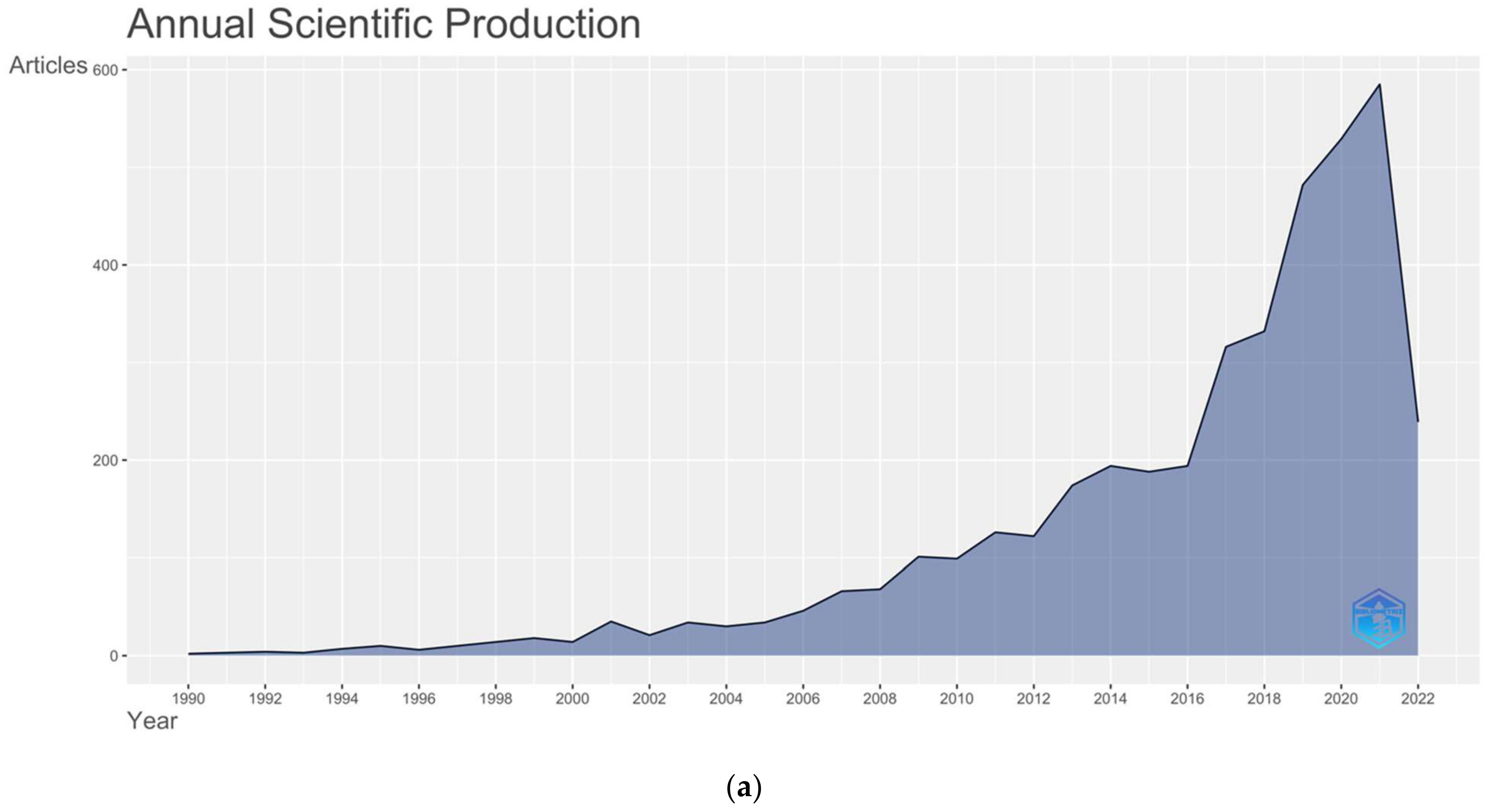
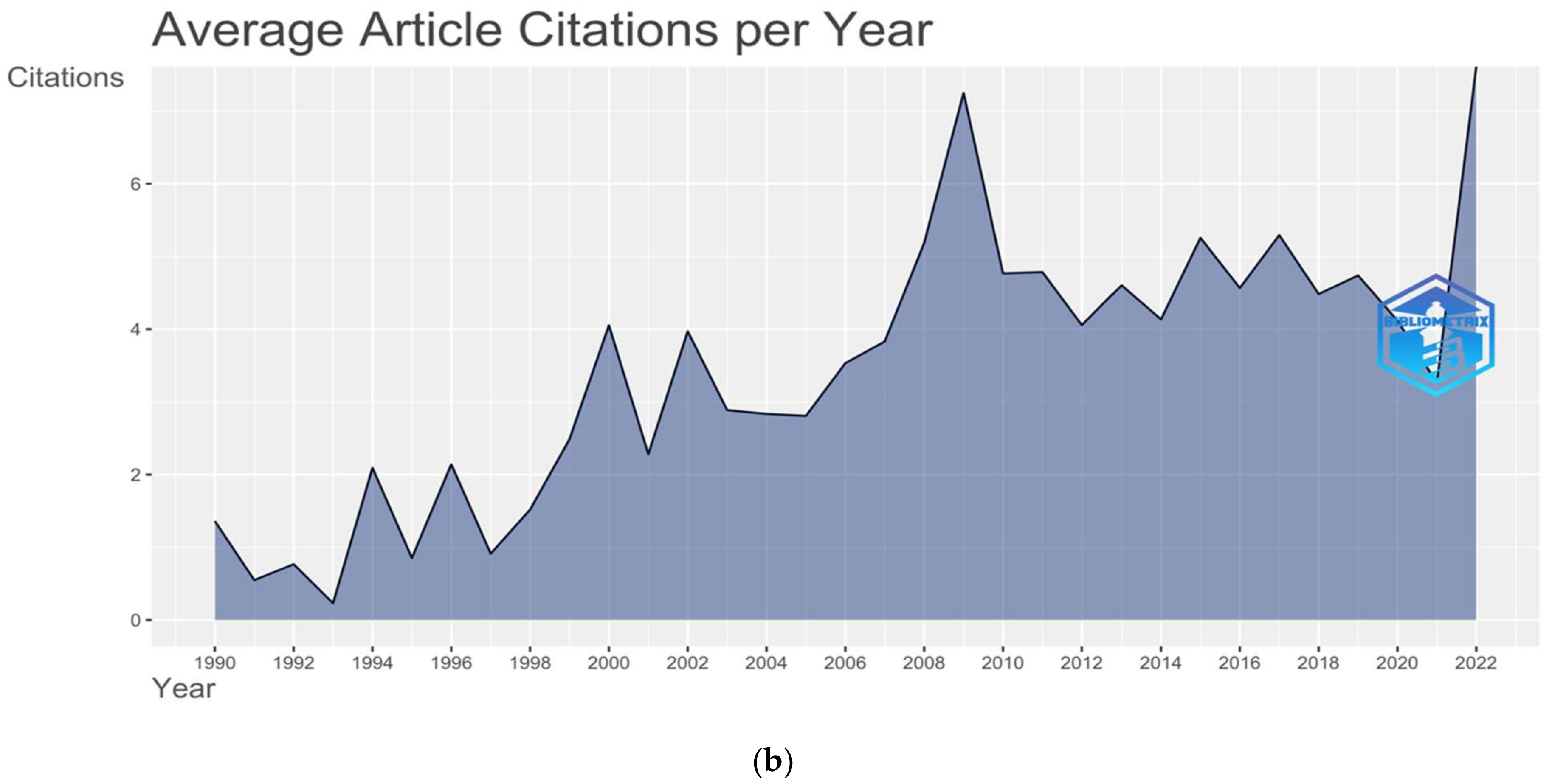
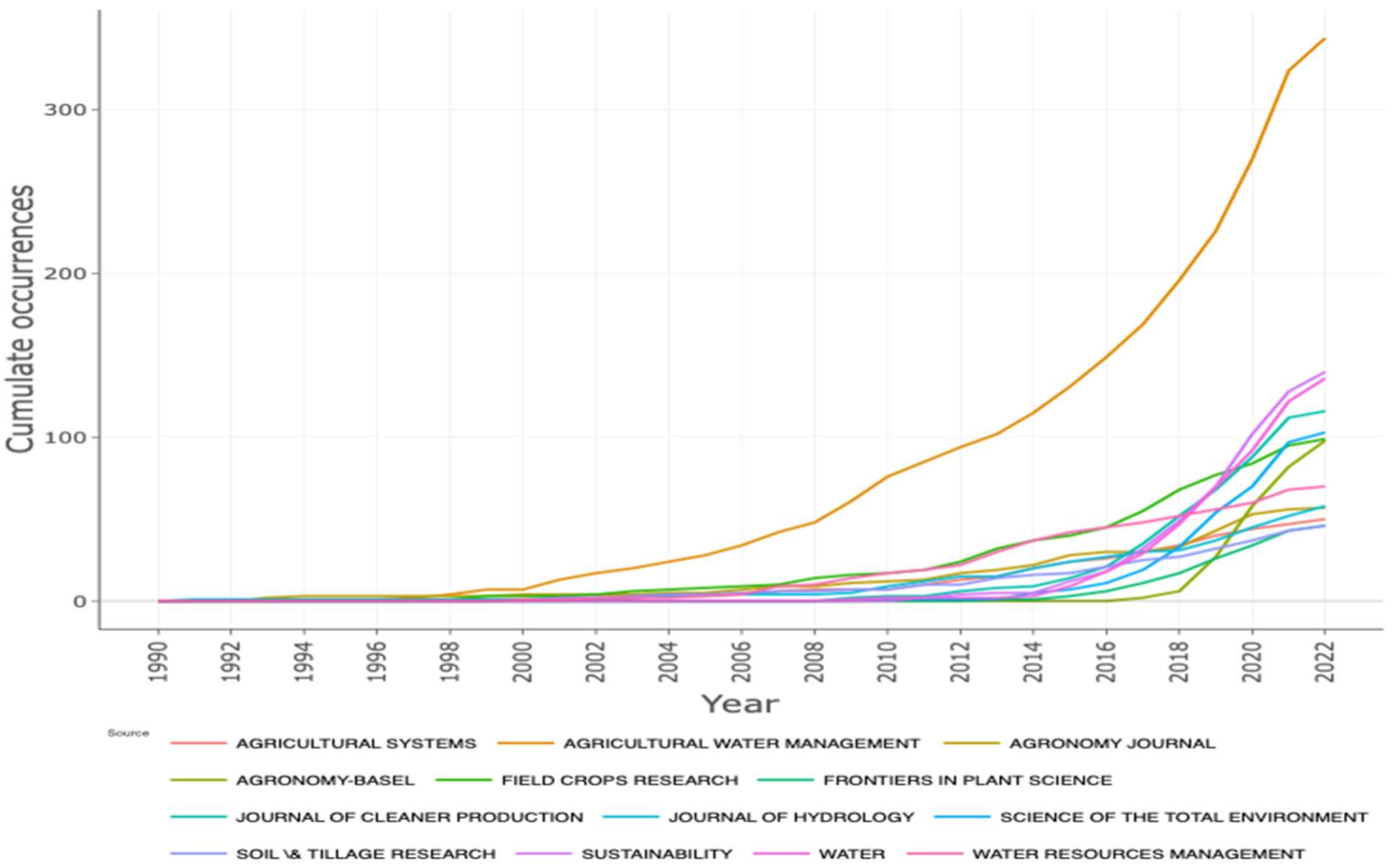
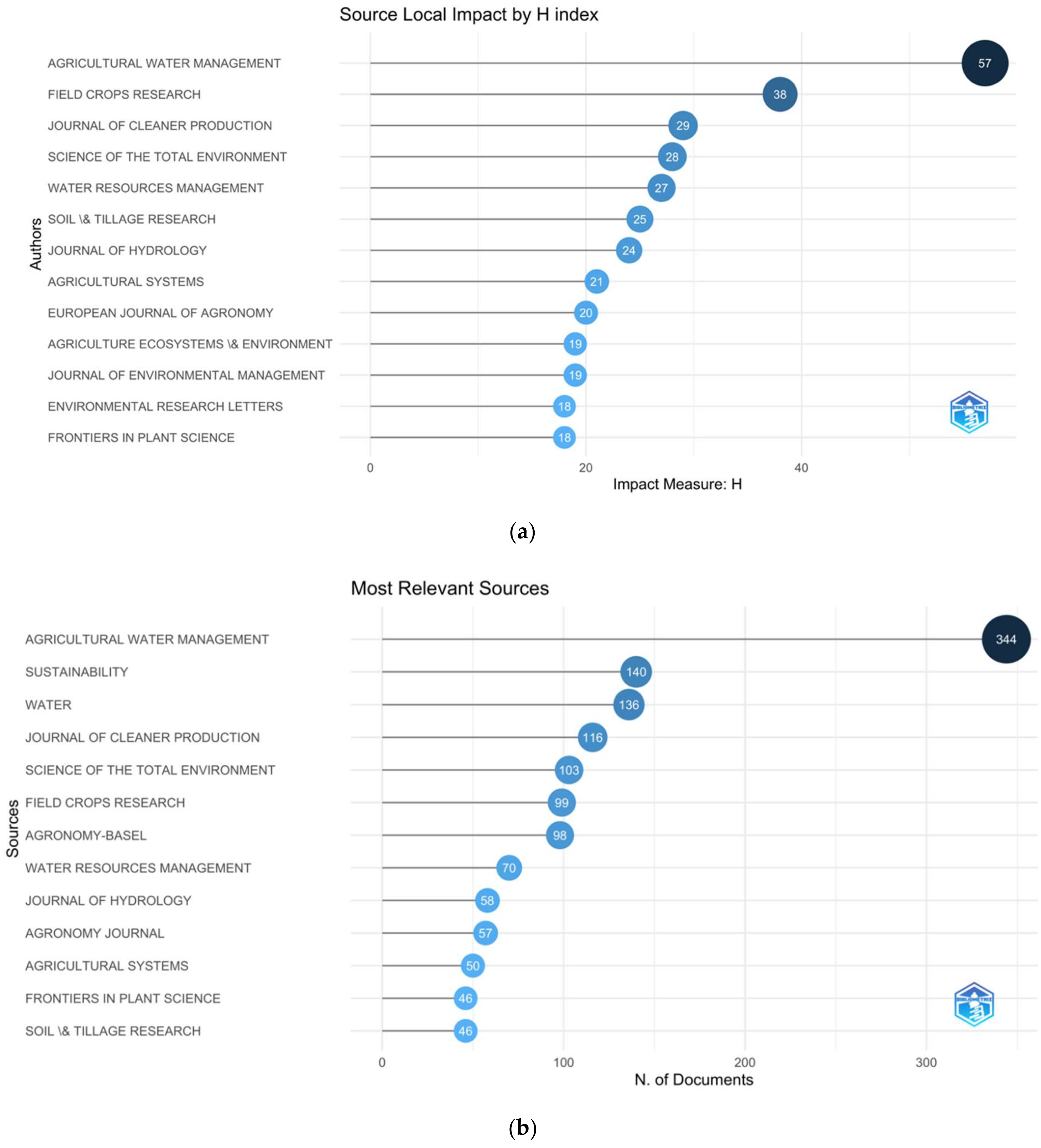
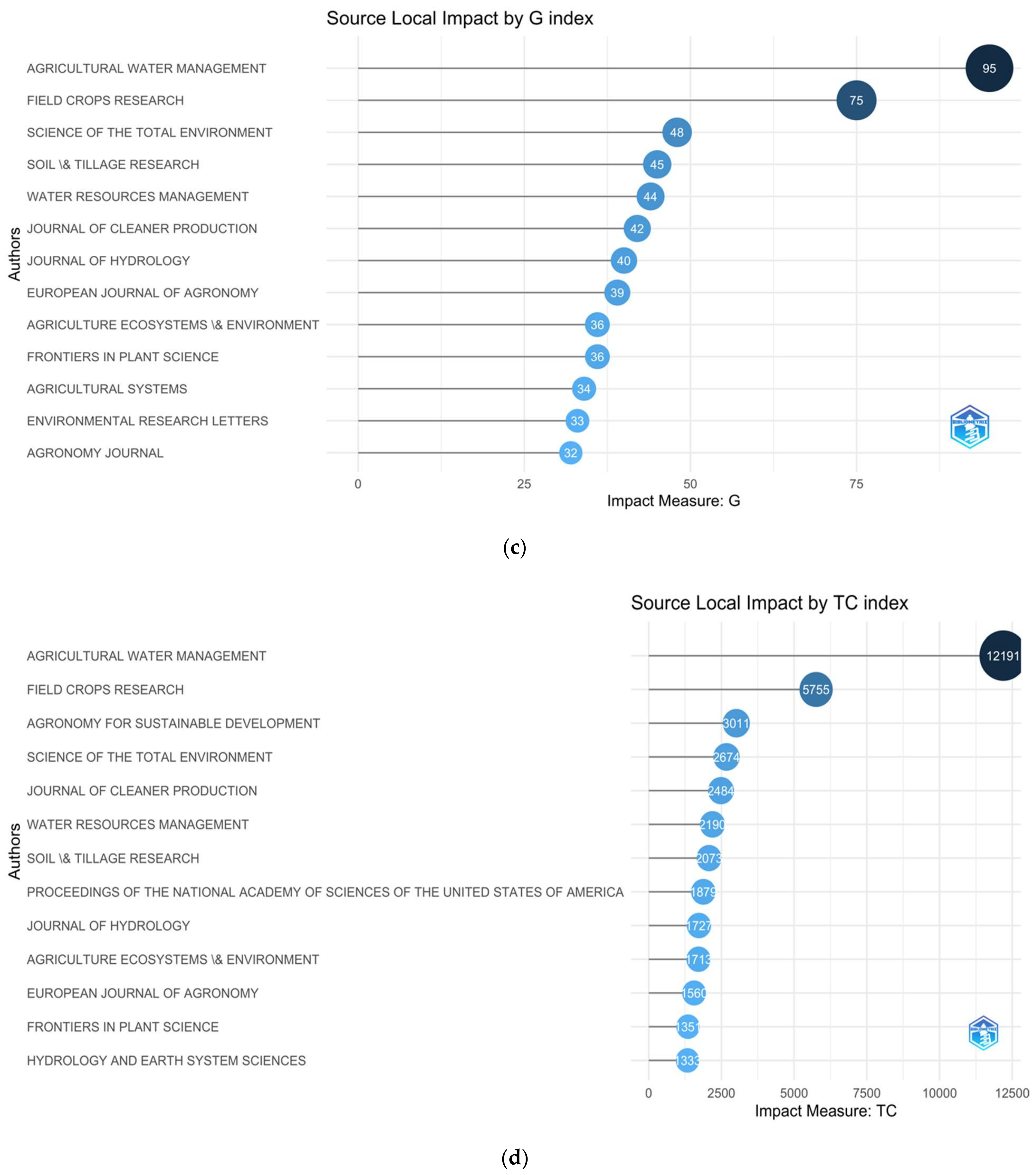
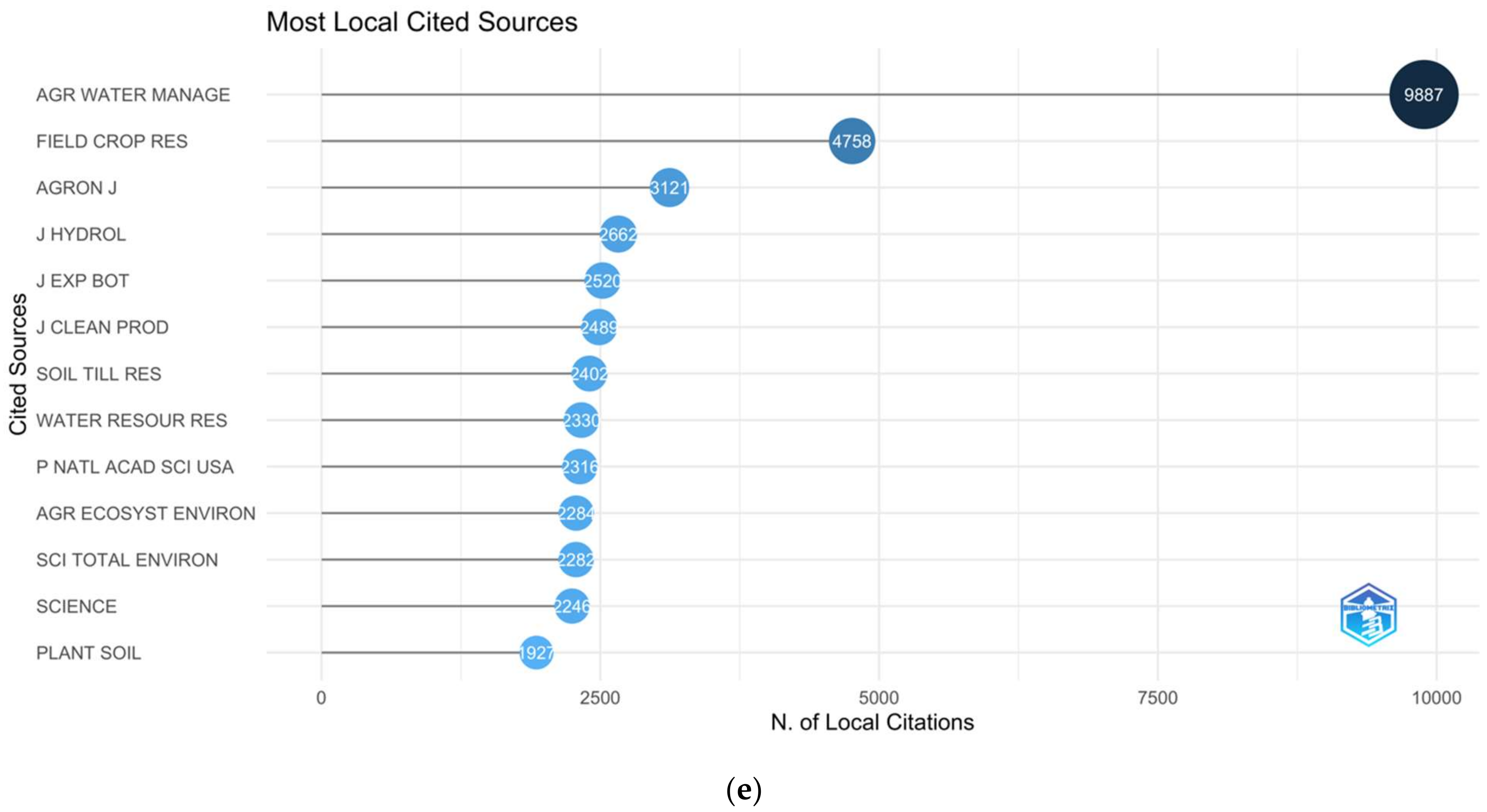
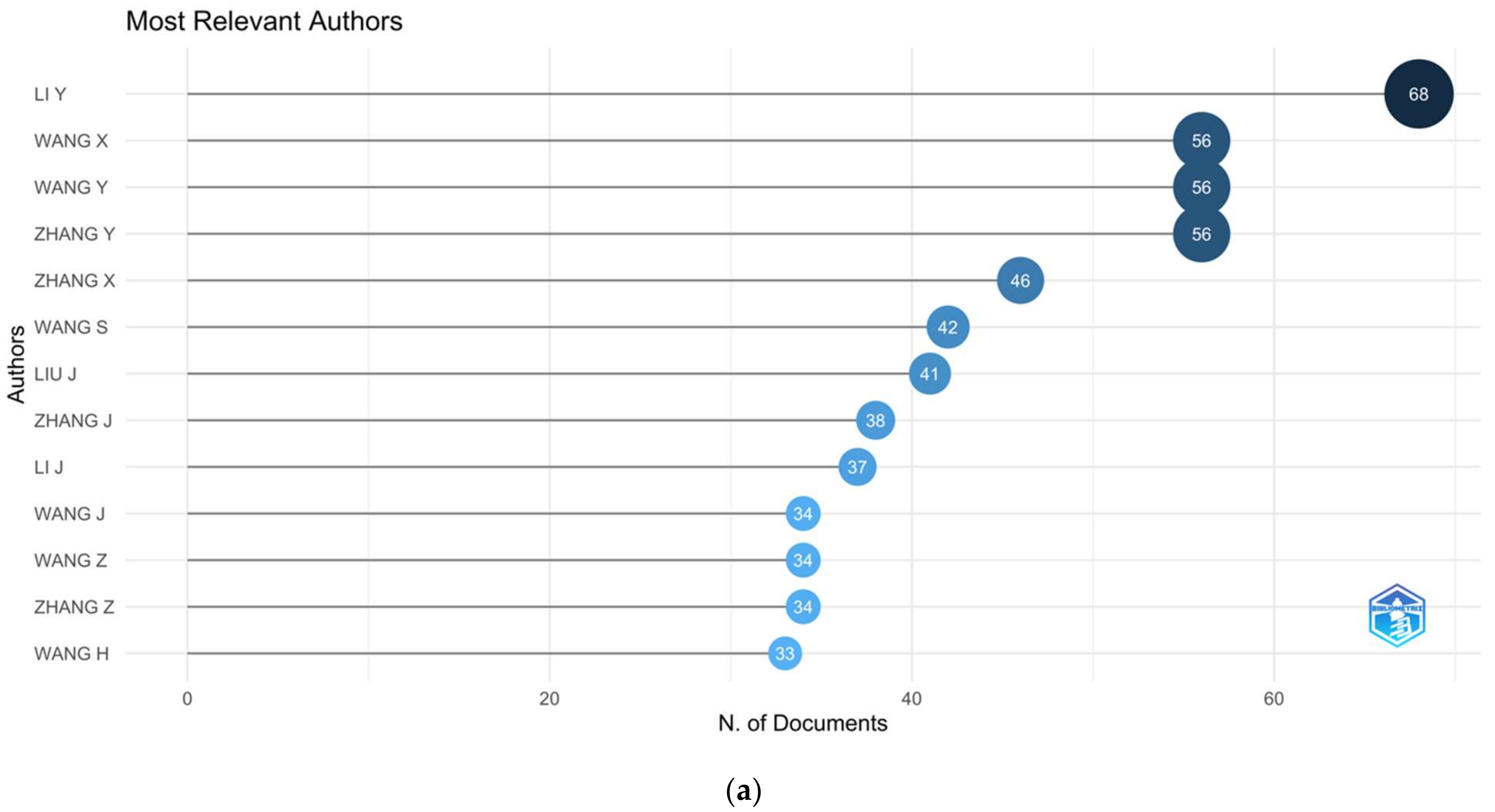
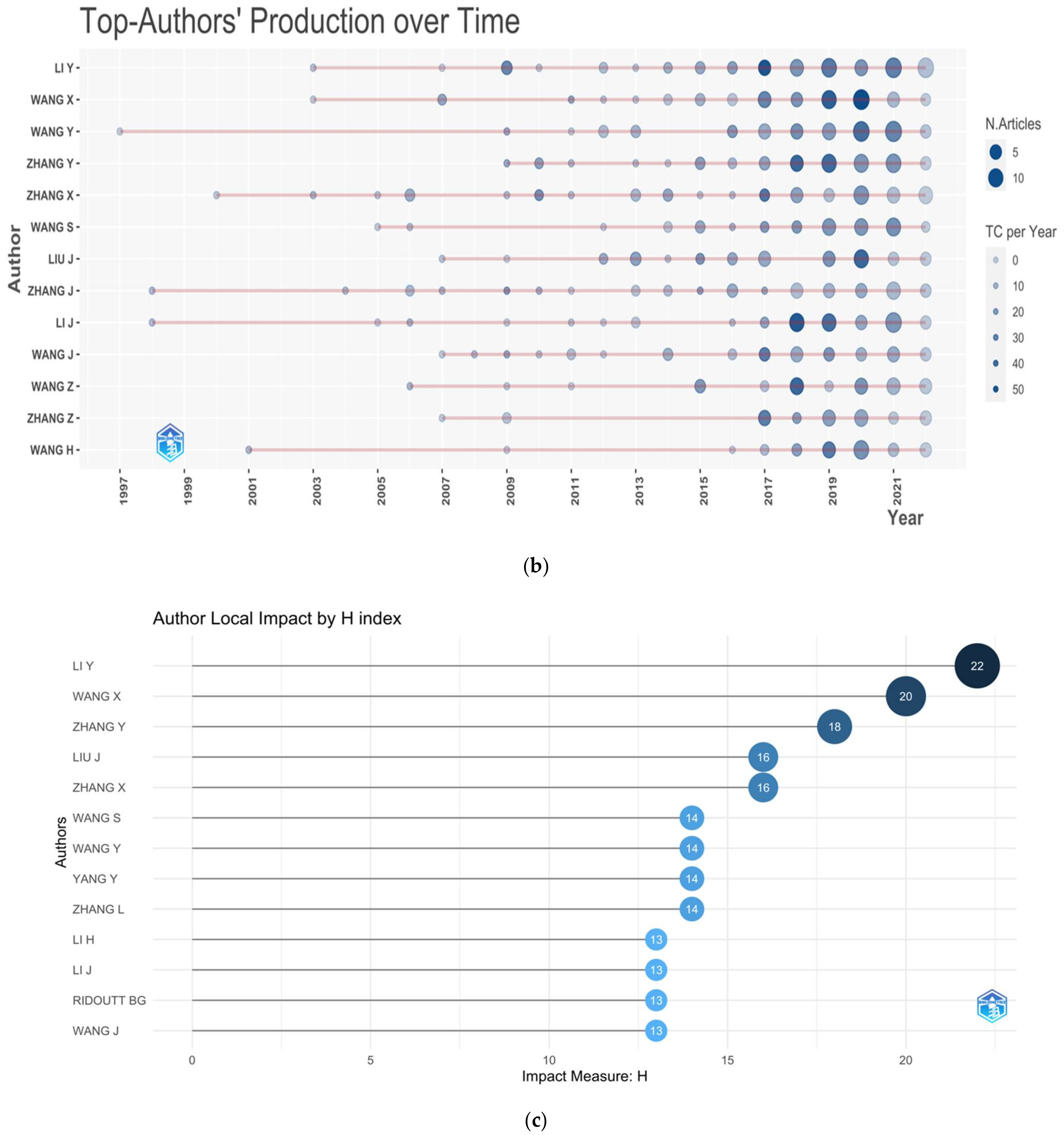
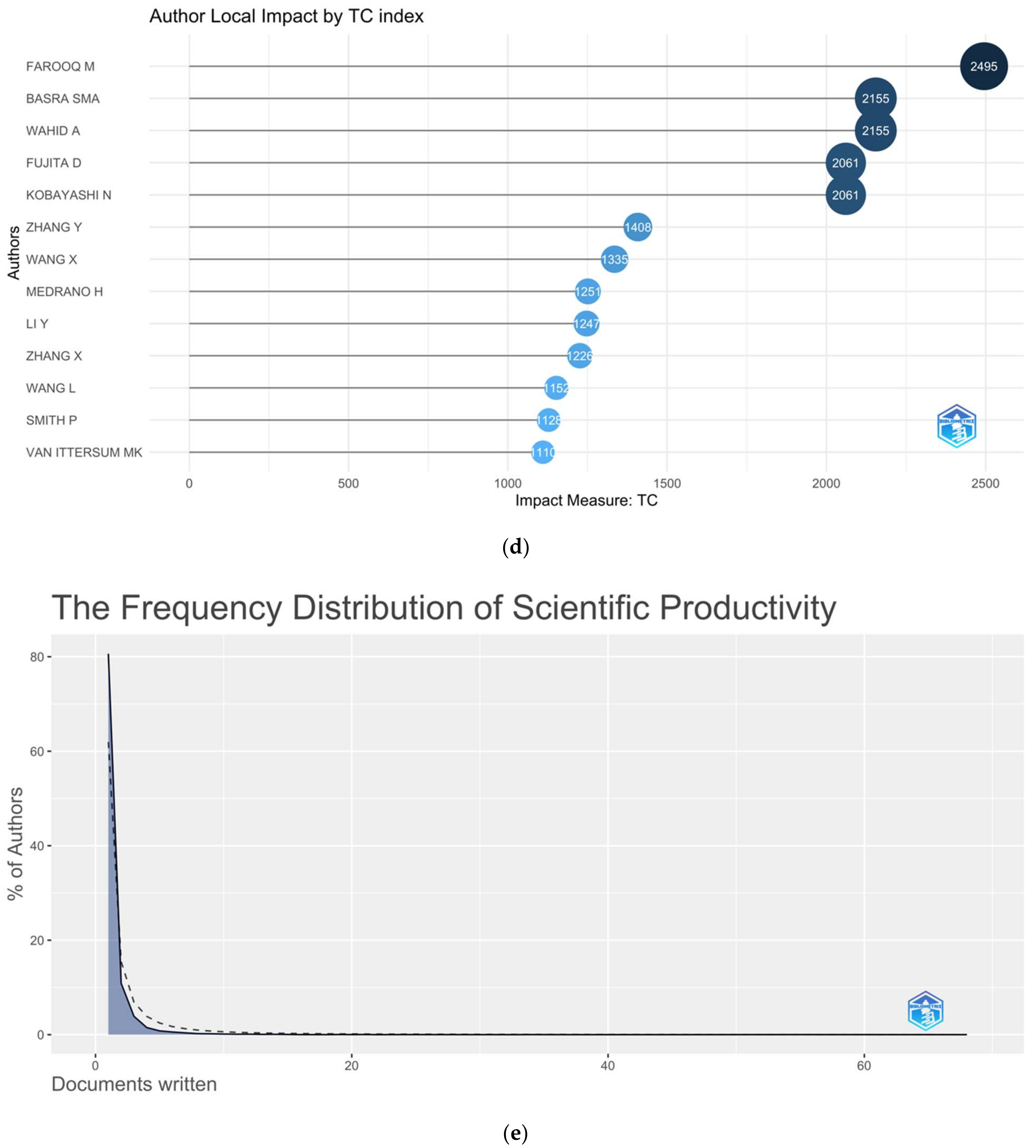
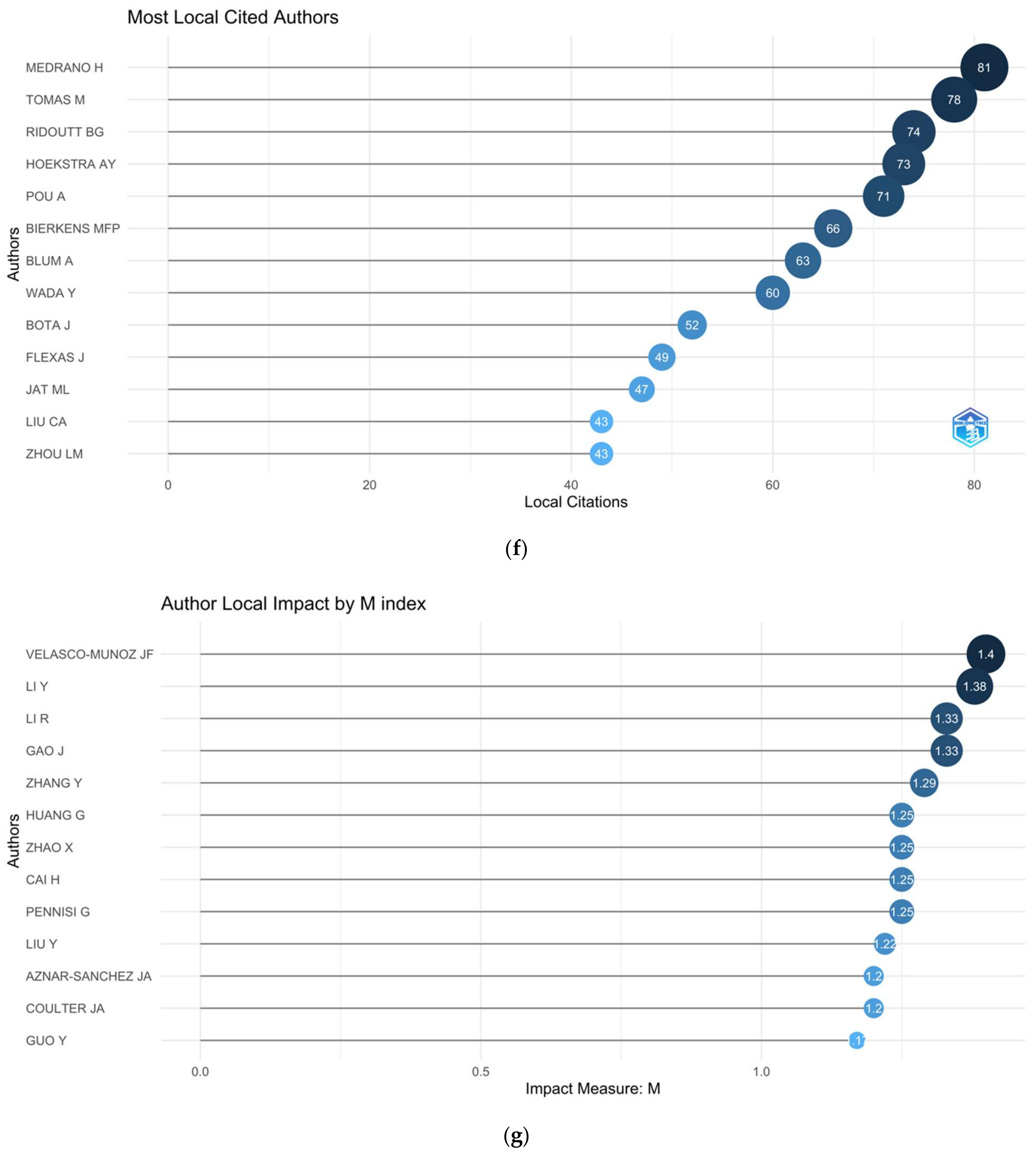
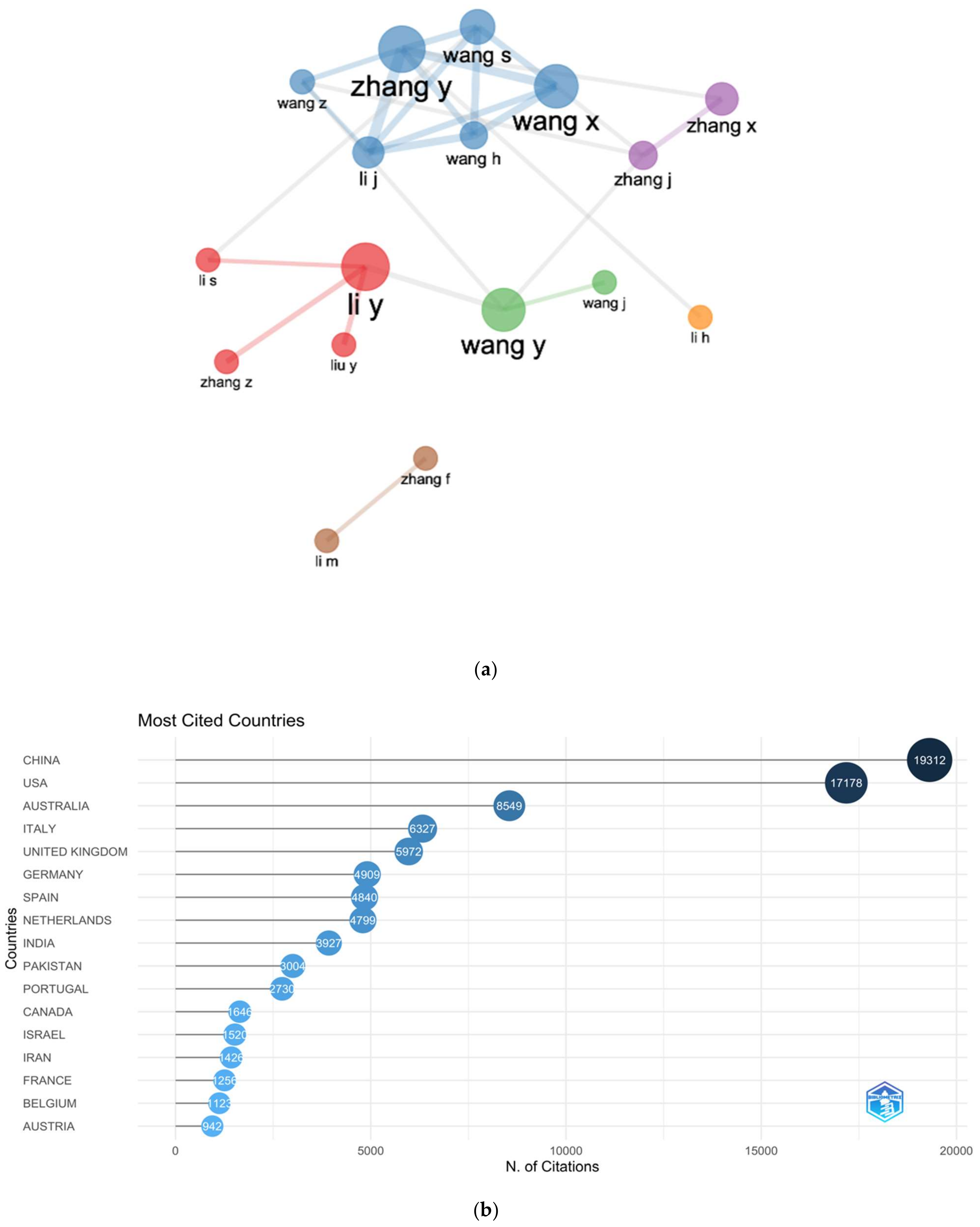
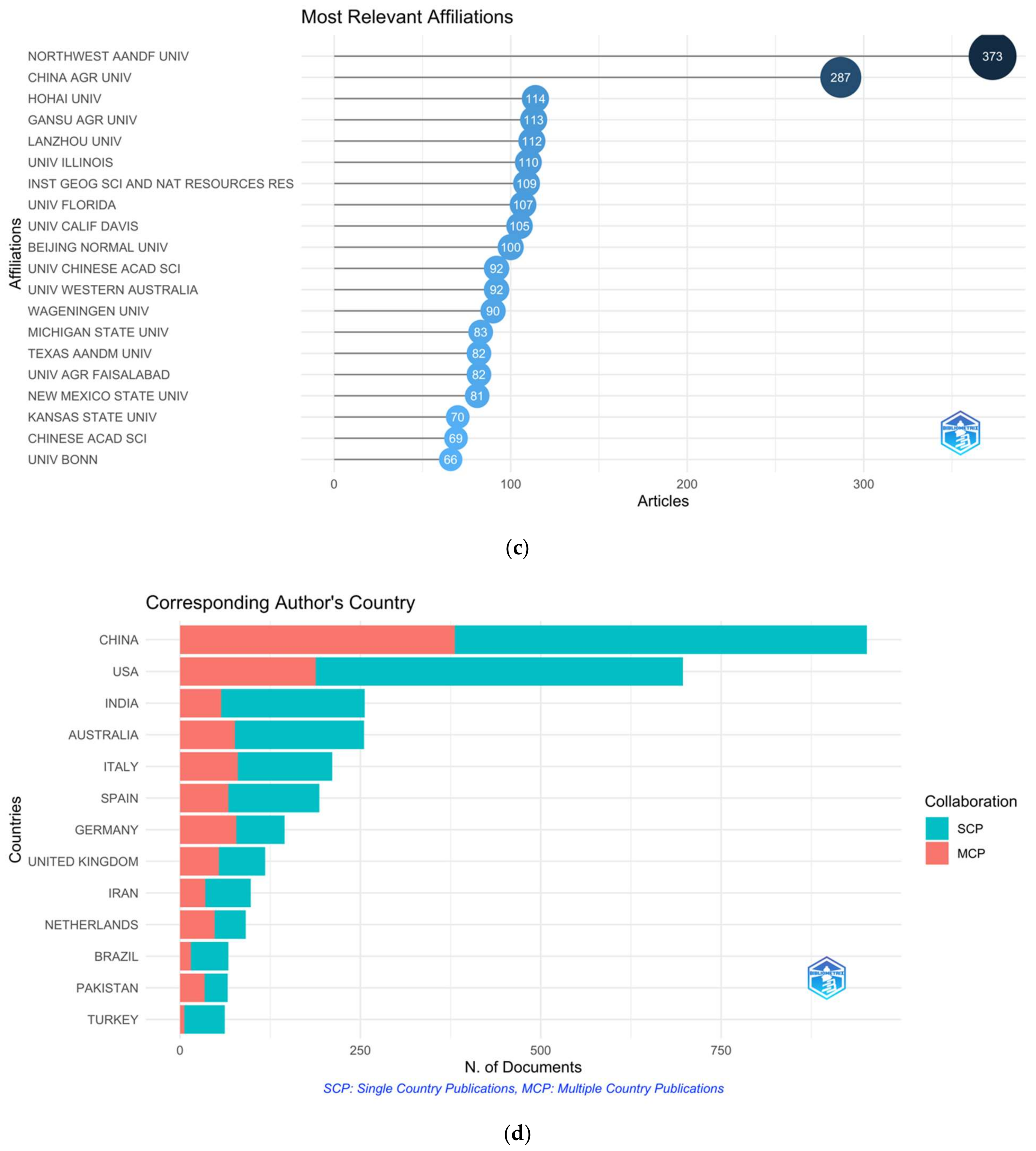
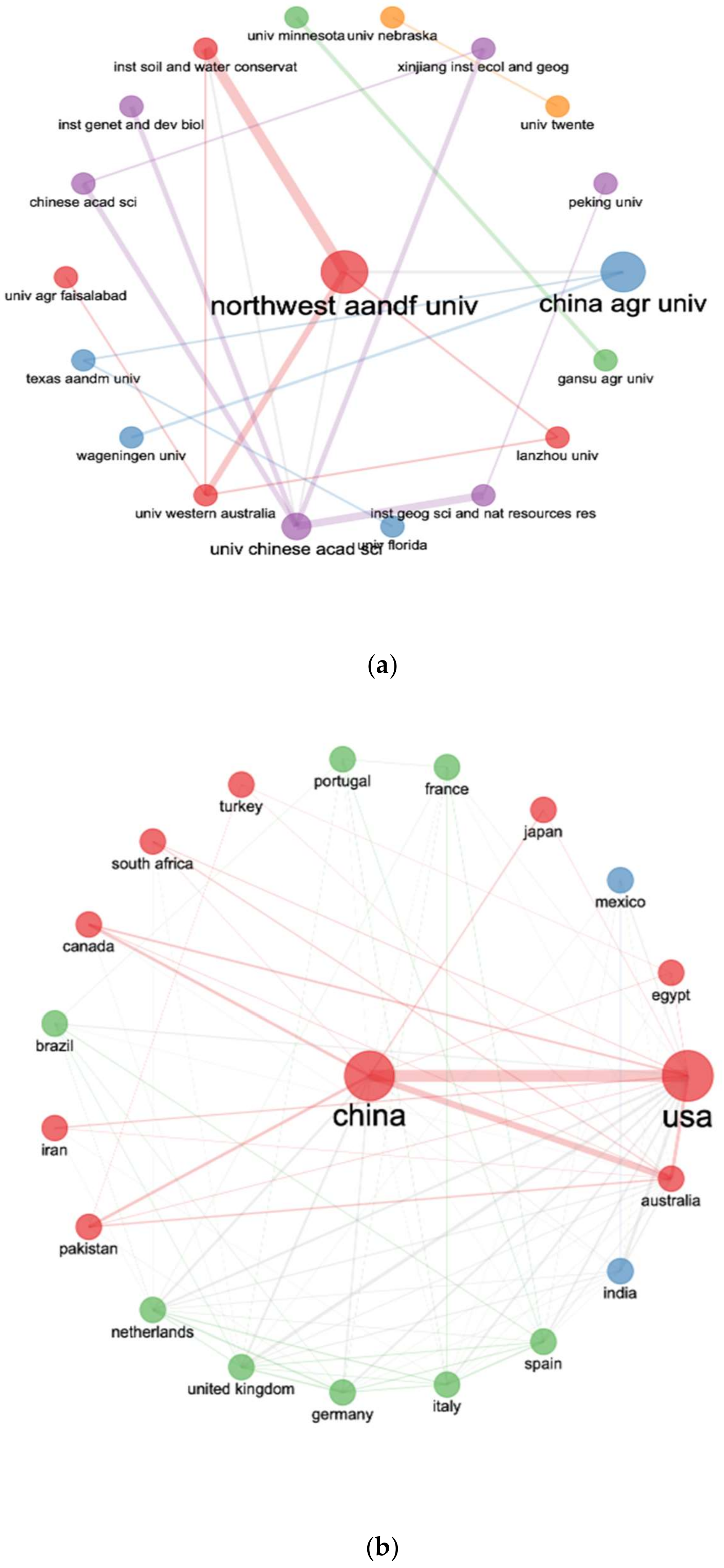

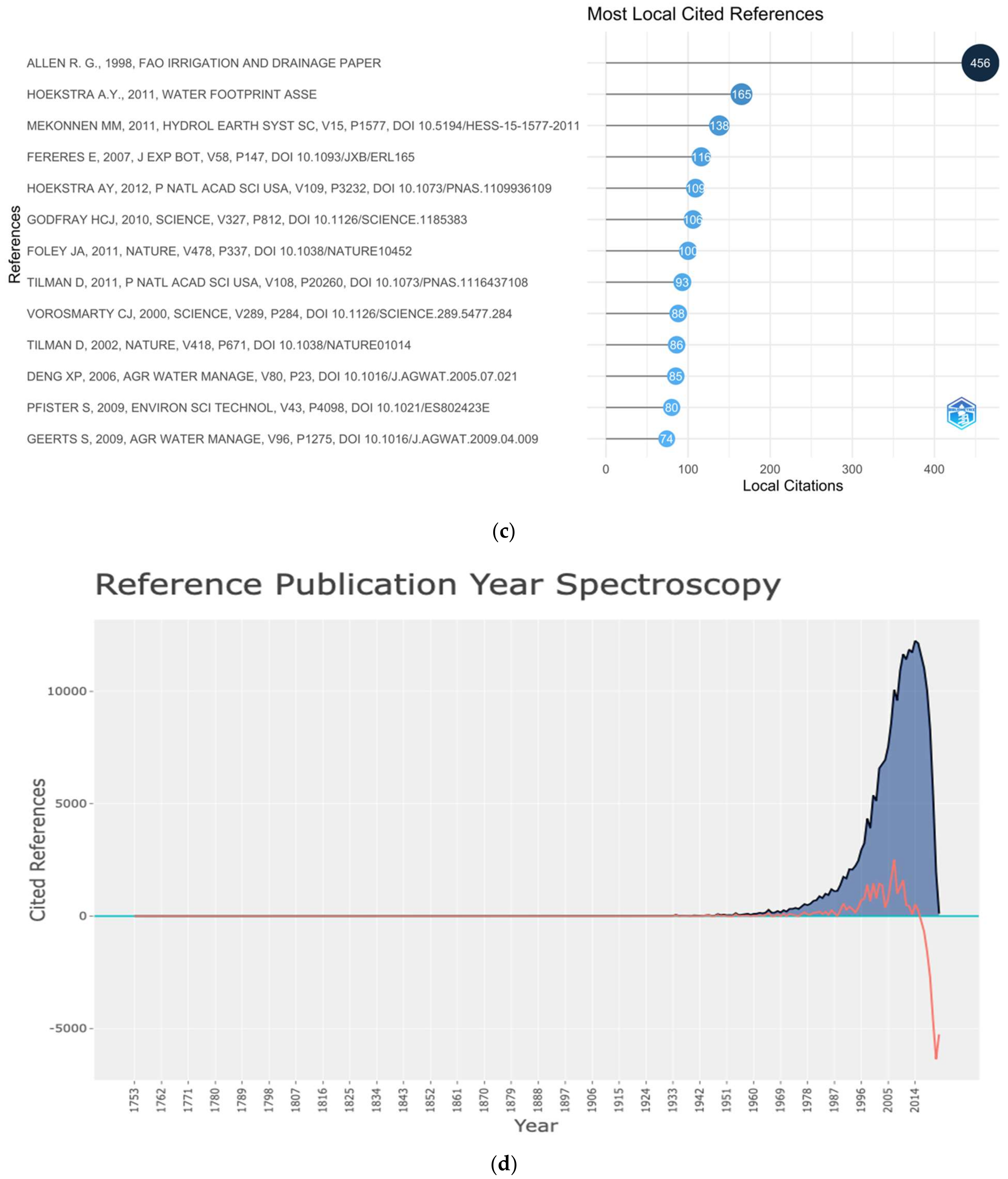
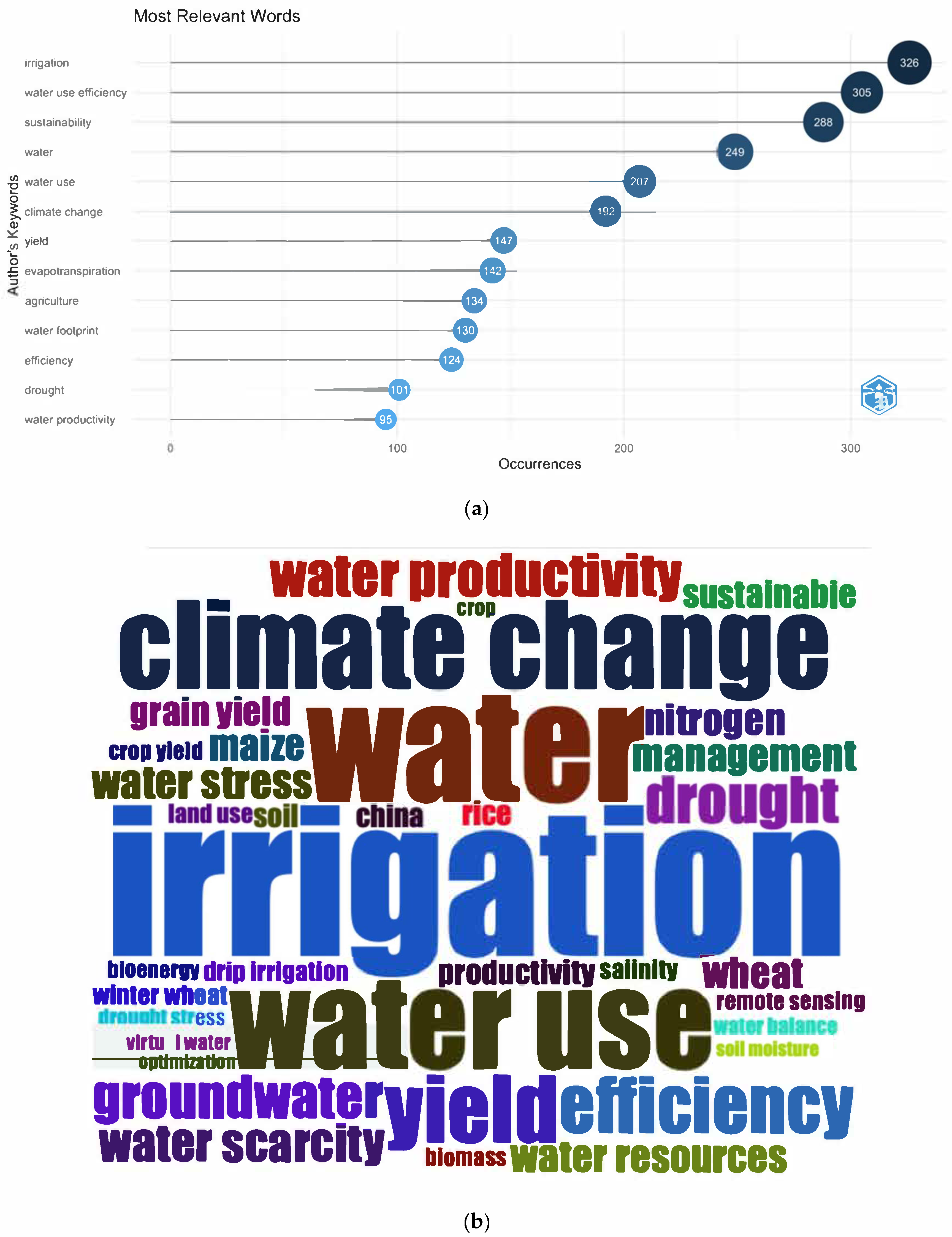
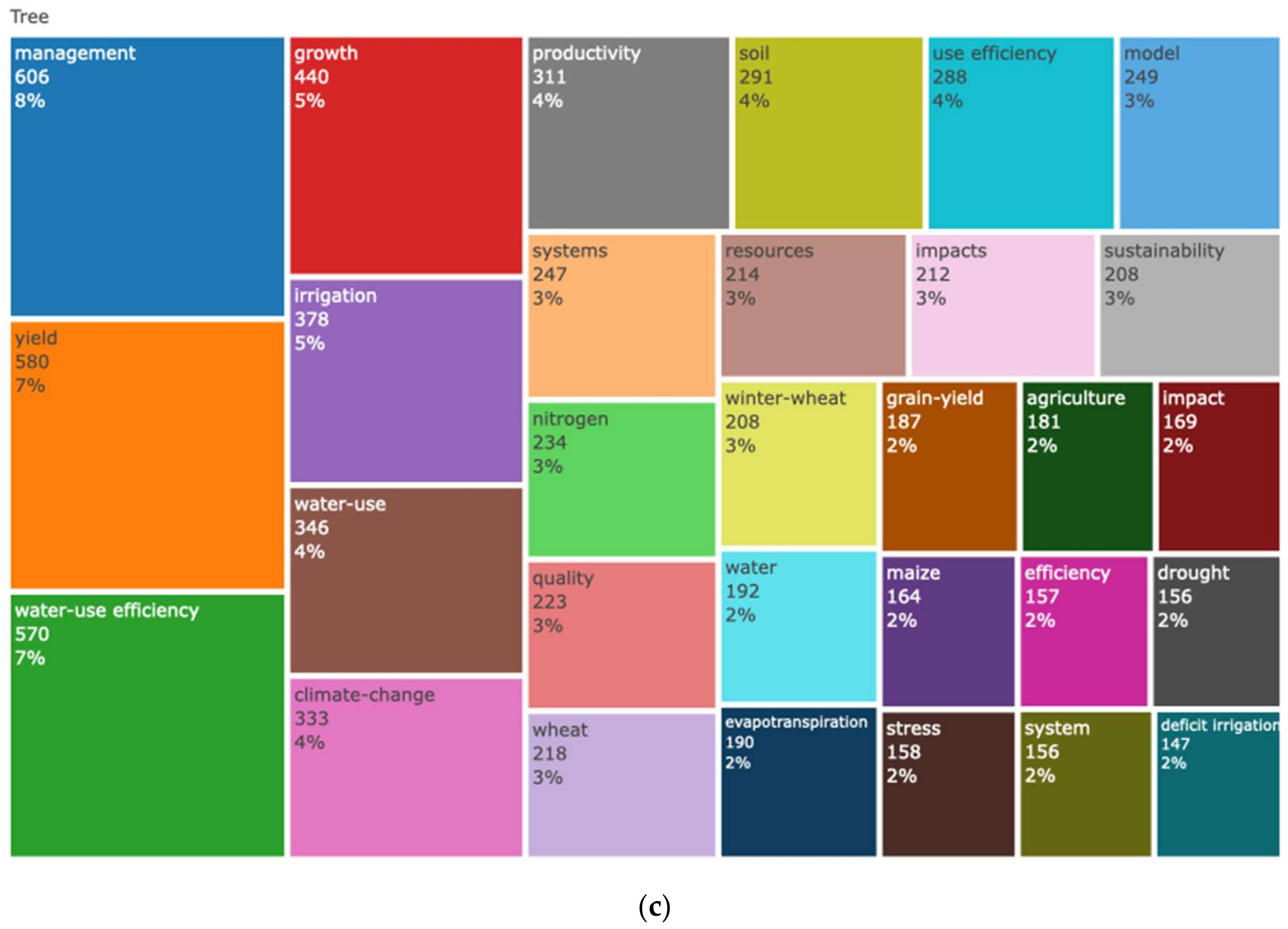
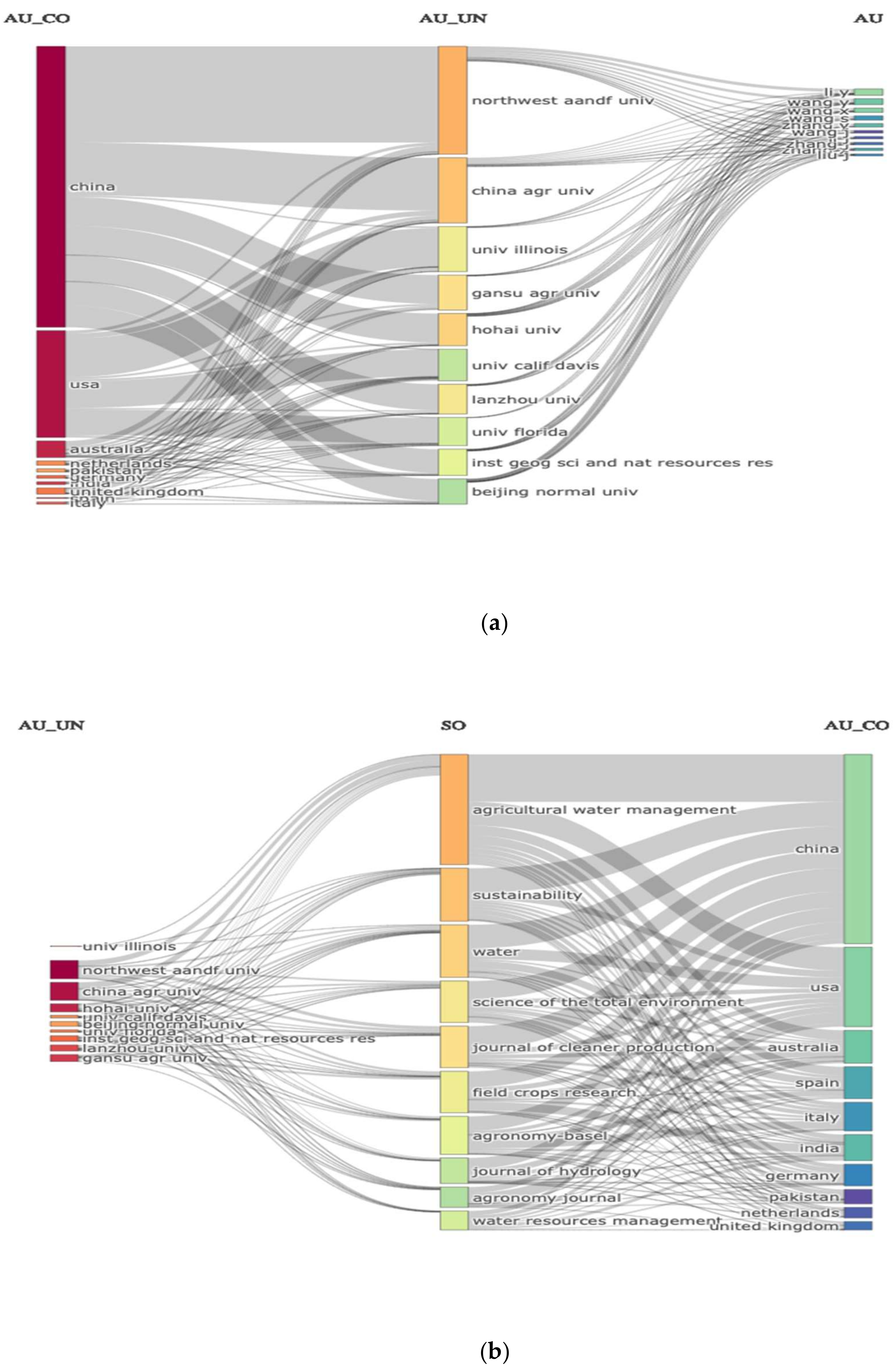
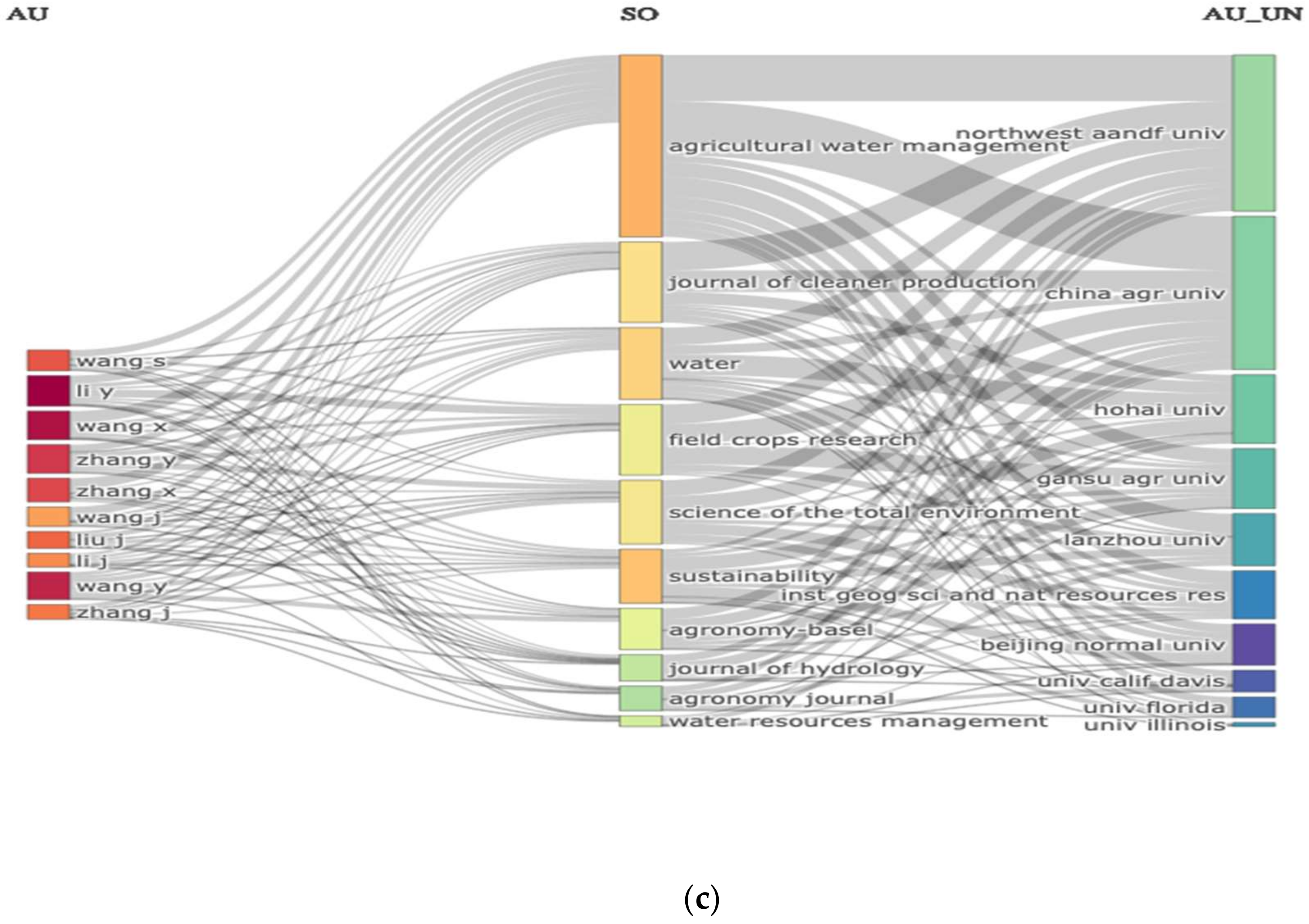
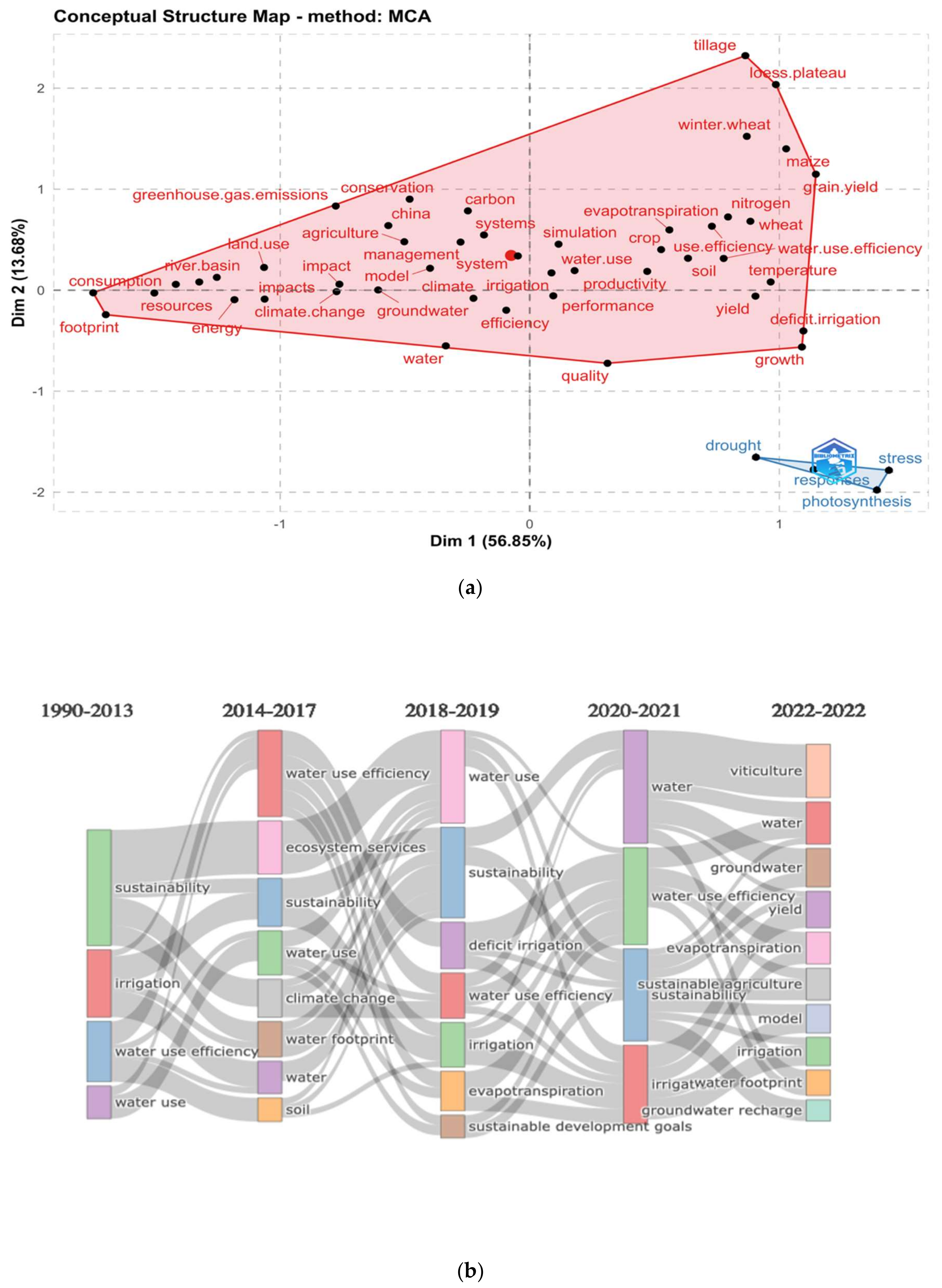
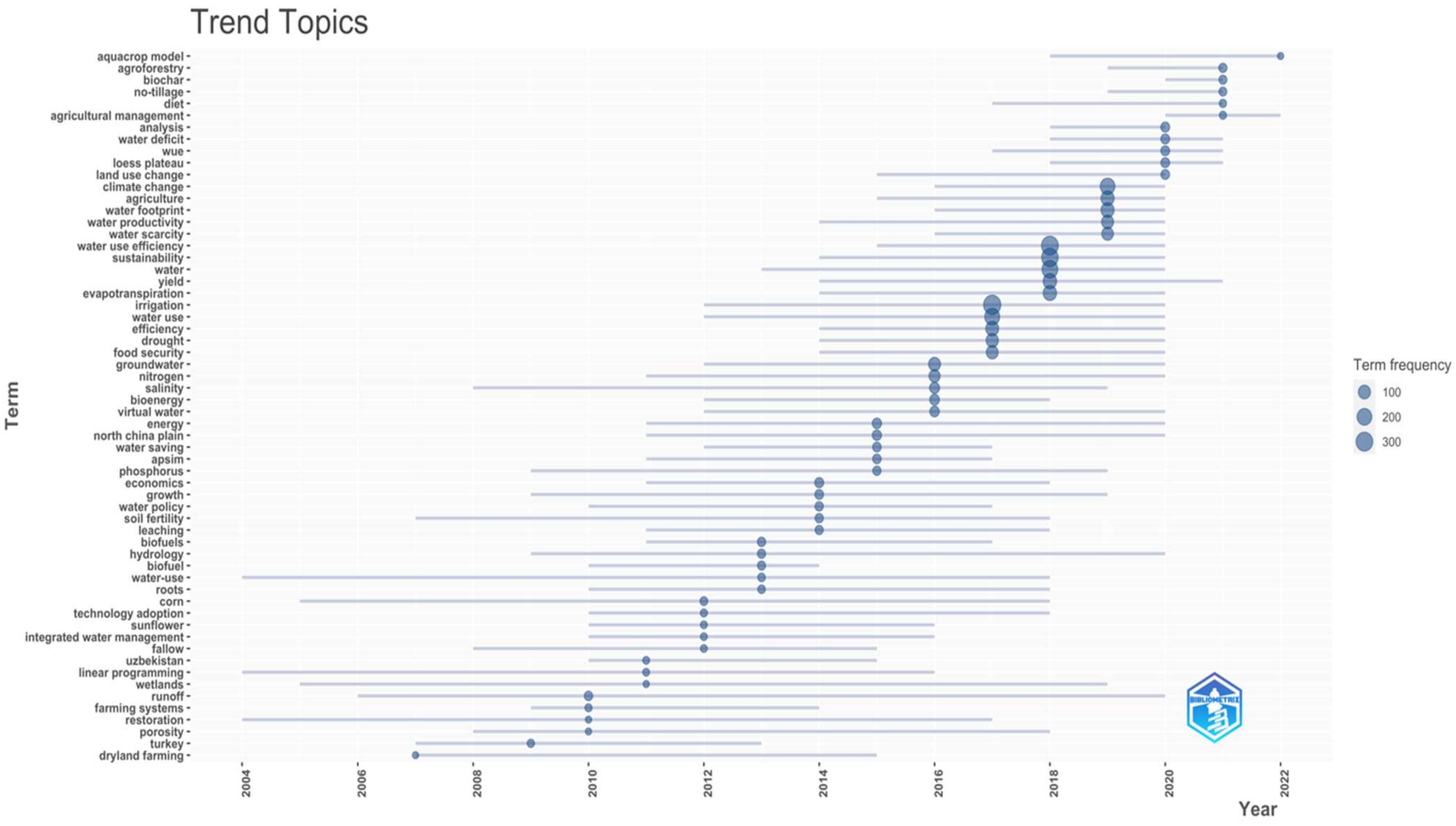
| Description | Results |
|---|---|
| Timespan | 1990:2022 |
| Sources (e.g., journals, book etc.) | 722 |
| Documents | 4106 |
| Average years from publication | 6 |
| Average citations per documents | 25.3 |
| Average citations per year per doc | 3.3 |
| References | 164,021 |
| Keywords Plus | 6842 |
| Author’s Keywords | 9838 |
| Authors | 12,686 |
| Author Appearances | 19,091 |
| Authors of multi-authored documents | 214 |
| Single-authored documents | 12,472 |
| Documents per Author | 0.3 |
| Authors per Document | 3 |
| Collaboration Index | 3.2 |
| Element | h_index | g_index | m_index | TC | NP | PY_start |
|---|---|---|---|---|---|---|
| AGRICULTURAL WATER MANAGEMENT | 57 | 95 | 1.966 | 12,191 | 324 | 1994 |
| FIELD CROPS RESEARCH | 38 | 75 | 1.52 | 5755 | 92 | 1998 |
| JOURNAL OF CLEANER PRODUCTION | 29 | 42 | 2.071 | 2484 | 109 | 2009 |
| SCIENCE OF THE TOTAL ENVIRONMENT | 28 | 48 | 2.154 | 2674 | 96 | 2010 |
| WATER RESOURCES MANAGEMENT | 27 | 44 | 1.174 | 2190 | 69 | 2000 |
| SOIL\& TILLAGE RESEARCH | 25 | 45 | 1.136 | 2073 | 45 | 2001 |
| JOURNAL OF HYDROLOGY | 24 | 40 | 0.75 | 1727 | 54 | 1991 |
| AGRICULTURAL SYSTEMS | 21 | 34 | 0.913 | 1298 | 48 | 2000 |
| EUROPEAN JOURNAL OF AGRONOMY | 20 | 39 | 0.714 | 1560 | 41 | 1995 |
| AGRICULTURE ECOSYSTEMS\& ENVIRONMENT | 19 | 36 | 0.905 | 1713 | 36 | 2002 |
| Authors | Articles | Articles Fractionalized |
|---|---|---|
| LI, Y. | 68 | 12.33 |
| WANG, X. | 56 | 10.93 |
| WANG, Y. | 56 | 10.81 |
| ZHANG, Y. | 56 | 9.26 |
| ZHANG, X. | 46 | 8.69 |
| WANG, S. | 42 | 8.08 |
| LIU, J. | 41 | 7.97 |
| ZHANG, J. | 38 | 6.99 |
| LI, J. | 37 | 6.82 |
| WANG, J. | 34 | 5.53 |
| Country | Total Citations | Average Article Citations | Number of Articles |
|---|---|---|---|
| China | 19,312 | 20.286 | 952 |
| USA | 17,178 | 24.646 | 697 |
| Australia | 8549 | 33.525 | 255 |
| Italy | 6327 | 29.986 | 211 |
| United Kingdom | 5972 | 50.61 | 118 |
| Germany | 4909 | 33.855 | 145 |
| Spain | 4840 | 25.078 | 193 |
| The Netherlands | 4799 | 52.736 | 91 |
| India | 3927 | 15.34 | 256 |
| Pakistan | 3004 | 45.515 | 66 |
| Portugal | 2730 | 52.5 | 52 |
| Canada | 1646 | 27.433 | 60 |
| Israel | 1520 | 80 | 19 |
| Paper | DOI | Total Citations | TC per Year | Normalized TC |
|---|---|---|---|---|
| FAROOQ M, 2009, AGRON SUSTAIN DEV [48] | 10.1051/agro:2008021 | 2061 | 147.2143 | 21.8748 |
| VAN ITTERSUM MK, 2013, FIELD CROP RES [49] | 10.1016/j.fcr.2012.09.009 | 827 | 82.7 | 19.9664 |
| GOUVEIA L, 2009, J IND MICROBIOL BIOTECHNOL [50] | 10.1007/s10295-008-0495-6 | 823 | 58.7857 | 8.7351 |
| CATTIVELLI L, 2008, FIELD CROP RES [51] | 10.1016/j.fcr.2007.07.004 | 750 | 50 | 10.3364 |
| BLUM A, 2009, FIELD CROP RES [53] | 10.1016/j.fcr.2009.03.009 | 685 | 48.9286 | 7.2704 |
| ANJUM SA, 2011, AFR J AGRIC RES [56] | NA | 674 | 56.1667 | 12.8071 |
| GEERTS S, 2009, AGRIC WATER MANAGE [57] | 10.1016/j.agwat.2009.04.009 | 547 | 39.0714 | 5.8057 |
| PEREIRA LS, 2002, AGRIC WATER MANAGE [58] | 10.1016/S0378-3774(02)00075-6 | 527 | 25.0952 | 6.6389 |
| STEINMETZ Z, 2016, SCI TOTAL ENVIRON [59] | 10.1016/j.scitotenv.2016.01.153 | 512 | 73.1429 | 18.6953 |
| STOLL M, 2000, J EXP BOT [60] | 10.1093/jexbot/51.350.1627 | 434 | 18.8696 | 4.8686 |
| SHAO HB, 2008, C R BIOL [61] | 10.1016/j.crvi.2008.01.002 | 430 | 28.6667 | 5.9262 |
| HAVLIK P, 2011, ENERGY POLICY [62] | 10.1016/j.enpol.2010.03.030 | 424 | 35.3333 | 8.0567 |
| GOMIERO T, 2011, CRIT REV PLANT SCI [63] | 10.1080/07352689.2011.554355 | 401 | 33.4167 | 7.6197 |
| WADA Y, 2014, EARTH SYST DYNAM [64] | 10.5194/esd-5-15-2014 | 382 | 42.4444 | 11.5523 |
| POSTEL SL, 2000, ECOL APPL [82] | 10.2307/2641009 | 381 | 16.5652 | 4.274 |
| WARD FA, 2008, PROC NATL ACAD SCI U S A [83] | 10.1073/pnas.0805554105 | 378 | 25.2 | 5.2096 |
| SHIFERAW B, 2013, FOOD SECUR [84] | 10.1007/s12571-013-0263-y | 370 | 37 | 8.933 |
| BOUMAN BAM, 2005, AGRIC WATER MANAGE [85] | 10.1016/j.agwat.2004.11.007 | 356 | 19.7778 | 7.4624 |
| KARP A, 2008, NEW PHYTOL [86] | 10.1111/j.1469-8137.2008.02432.x | 349 | 23.2667 | 4.8099 |
| SMITH P, 2007, AGRIC ECOSYST ENVIRON [87] | 10.1016/j.agee.2006.06.006 | 345 | 21.5625 | 6.0047 |
| CREUTZIG F, 2015, GCB BIOENERGY [88] | 10.1111/gcbb.12205 | 342 | 42.75 | 9.298 |
| MORISON JIL, 2008, PHILOS TRANS R SOC B-BIOL SCI [89] | 10.1098/rstb.2007.2175 | 341 | 22.7333 | 4.6996 |
| REYNOLDS M, 2012, PLANT CELL ENVIRON [90] | 10.1111/j.1365-3040.2012.02588.x | 321 | 29.1818 | 7.9163 |
| BLUM A, 2017, PLANT CELL ENVIRON [91] | 10.1111/pce.12800 | 307 | 51.1667 | 11.6015 |
| Document | DOI | Year | LC | GC | LC/GC Ratio (%) | NLC | NGC |
|---|---|---|---|---|---|---|---|
| BLUM A, 2009, FIELD CROP RES [53] | 10.1016/j.fcr.2009.03.009 | 2009 | 55 | 685 | 8.03 | 27.10 | 7.27 |
| MEDRANO H, 2015, CROP J [55] | 10.1016/j.cj.2015.04.002 | 2015 | 29 | 236 | 12.29 | 22.72 | 6.42 |
| LIU CA, 2009, EUR J AGRON [54] | 10.1016/j.eja.2009.08.004 | 2009 | 27 | 250 | 10.80 | 13.30 | 2.65 |
| WADA Y, 2014, ENVIRON RES LETT [65] | 10.1088/1748-9326/9/10/104003 | 2014 | 26 | 208 | 12.50 | 19.03 | 6.29 |
| VAN ITTERSUM MK, 2013, FIELD CROP RES [49] | 10.1016/j.fcr.2012.09.009 | 2013 | 25 | 827 | 3.02 | 19.16 | 19.97 |
| MEDRANO H, 2015, AGRON SUSTAIN DEV [66] | 10.1007/s13593-014-0280-z | 2015 | 23 | 124 | 18.55 | 18.02 | 3.37 |
| STOLL M, 2000, J EXP BOT [60] | 10.1093/jexbot/51.350.1627 | 2000 | 22 | 434 | 5.07 | 10.27 | 4.87 |
| WADA Y, 2014, EARTH SYST DYNAM [64] | 10.5194/esd-5-15-2014 | 2014 | 22 | 382 | 5.76 | 16.11 | 11.55 |
| VANHAM D, 2013, ECOL INDIC [67] | 10.1016/j.ecolind.2012.10.021 | 2013 | 21 | 139 | 15.11 | 16.10 | 3.36 |
| CATTIVELLI L, 2008, FIELD CROP RES [51] | 10.1016/j.fcr.2007.07.004 | 2008 | 20 | 750 | 2.67 | 10.71 | 10.34 |
| PAGE G, 2012, J CLEAN PROD [68] | 10.1016/j.jclepro.2012.03.036 | 2012 | 20 | 125 | 16.00 | 14.19 | 3.08 |
| LAMASTRA L, 2014, SCI TOTAL ENVIRON [69] | 10.1016/j.scitotenv.2014.05.063 | 2014 | 19 | 91 | 20.88 | 13.91 | 2.75 |
| HUANG GB, 2008, FIELD CROP RES [70] | 10.1016/j.fcr.2007.12.011 | 2008 | 17 | 73 | 23.29 | 9.10 | 1.01 |
| ENE SA, 2013, J CLEAN PROD [92] | 10.1016/j.jclepro.2012.11.051 | 2013 | 17 | 93 | 18.28 | 13.03 | 2.25 |
| JAT ML, 2013, FIELD CROP RES [93] | 10.1016/j.fcr.2013.04.024 | 2013 | 17 | 97 | 17.53 | 13.03 | 2.34 |
| HOEKSTRA AY, 2017, WATER RESOUR MANAG [94] | 10.1007/s11269-017-1618-5 | 2017 | 17 | 123 | 13.82 | 20.58 | 4.65 |
| CHEN JY, 2003, ENVIRON GEOL [95] | 10.1007/s00254-003-0792-3 | 2003 | 16 | 68 | 23.53 | 16.00 | 1.24 |
| KARP A, 2008, NEW PHYTOL [86] | 10.1111/j.1469-8137.2008.02432.x | 2008 | 16 | 349 | 4.58 | 8.57 | 4.81 |
| TOMAS M, 2014, ENVIRON EXP BOT [96] | 10.1016/j.envexpbot.2013.09.003 | 2014 | 16 | 80 | 20.00 | 11.71 | 2.42 |
| LIU CA, 2014, EUR J AGRON [97] | 10.1016/j.eja.2013.10.001 | 2014 | 16 | 87 | 18.39 | 11.71 | 2.63 |
| PARIHAR CM, 2016, FIELD CROP RES [98] | 10.1016/j.fcr.2016.03.013 | 2016 | 16 | 67 | 23.88 | 21.86 | 2.45 |
| ZHANG JH, 1998, FIELD CROP RES [99] | 10.1016/S0378-4290(98)00104-X | 1998 | 15 | 162 | 9.26 | 10.00 | 4.45 |
| RIDOUTT BG, 2009, J CLEAN PROD [100] | 10.1016/j.jclepro.2009.03.002 | 2009 | 15 | 82 | 18.29 | 7.39 | 0.87 |
| GATHALA MK, 2011, AGRON J [101] | 10.2134/agronj2010.0394 | 2011 | 15 | 114 | 13.16 | 15.49 | 2.17 |
| SINGH A, 2014, J HYDROL [102] | 10.1016/j.jhydrol.2014.09.049 | 2014 | 15 | 92 | 16.30 | 10.98 | 2.78 |
Publisher’s Note: MDPI stays neutral with regard to jurisdictional claims in published maps and institutional affiliations. |
© 2022 by the authors. Licensee MDPI, Basel, Switzerland. This article is an open access article distributed under the terms and conditions of the Creative Commons Attribution (CC BY) license (https://creativecommons.org/licenses/by/4.0/).
Share and Cite
Abafe, E.A.; Bahta, Y.T.; Jordaan, H. Exploring Biblioshiny for Historical Assessment of Global Research on Sustainable Use of Water in Agriculture. Sustainability 2022, 14, 10651. https://doi.org/10.3390/su141710651
Abafe EA, Bahta YT, Jordaan H. Exploring Biblioshiny for Historical Assessment of Global Research on Sustainable Use of Water in Agriculture. Sustainability. 2022; 14(17):10651. https://doi.org/10.3390/su141710651
Chicago/Turabian StyleAbafe, Ejovi Akpojevwe, Yonas T. Bahta, and Henry Jordaan. 2022. "Exploring Biblioshiny for Historical Assessment of Global Research on Sustainable Use of Water in Agriculture" Sustainability 14, no. 17: 10651. https://doi.org/10.3390/su141710651
APA StyleAbafe, E. A., Bahta, Y. T., & Jordaan, H. (2022). Exploring Biblioshiny for Historical Assessment of Global Research on Sustainable Use of Water in Agriculture. Sustainability, 14(17), 10651. https://doi.org/10.3390/su141710651







